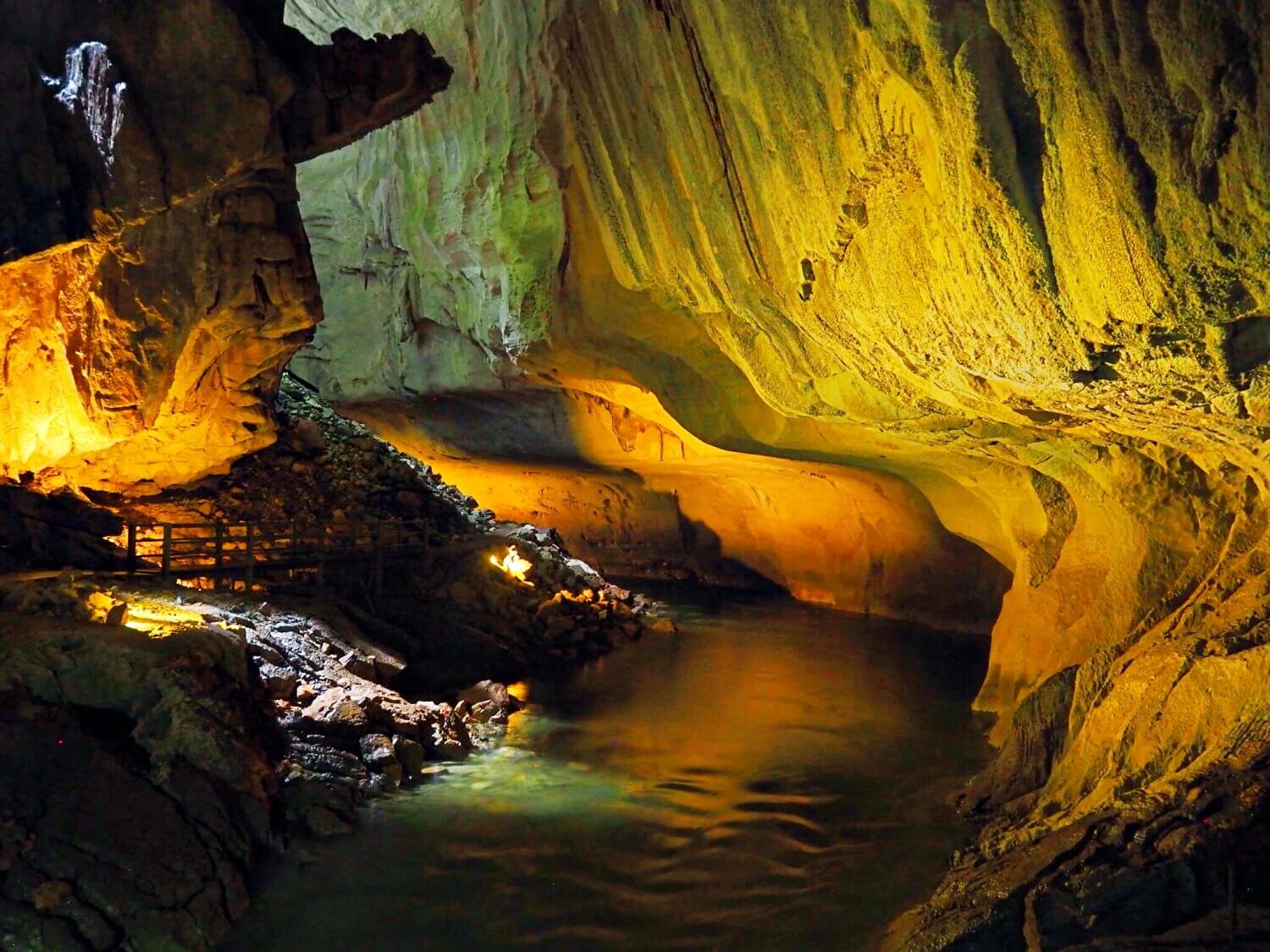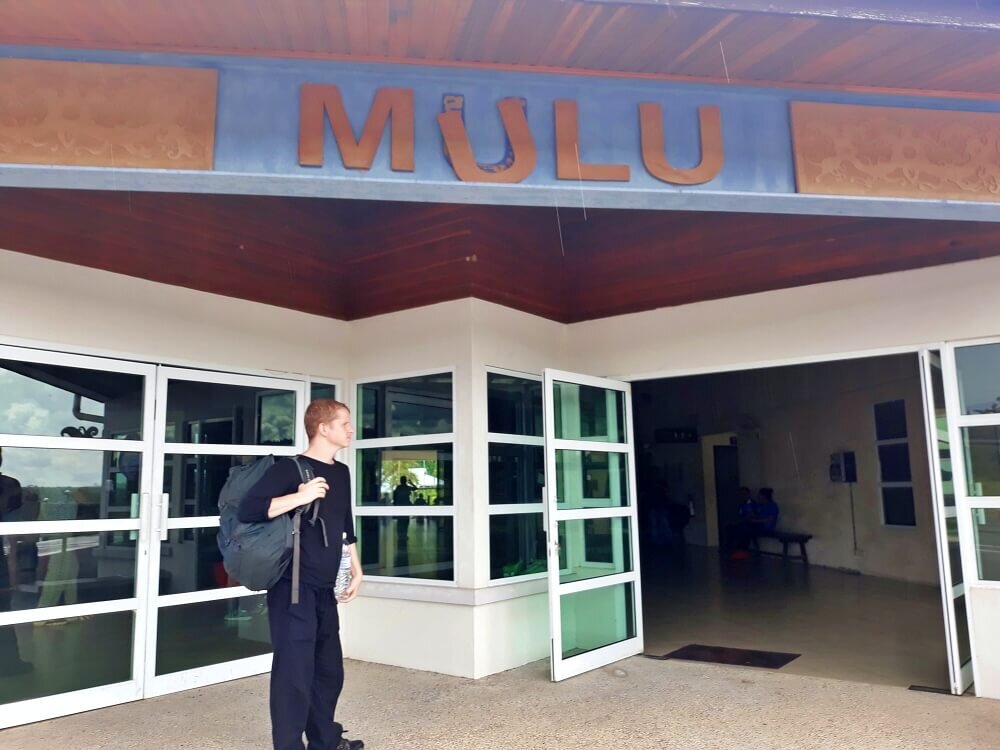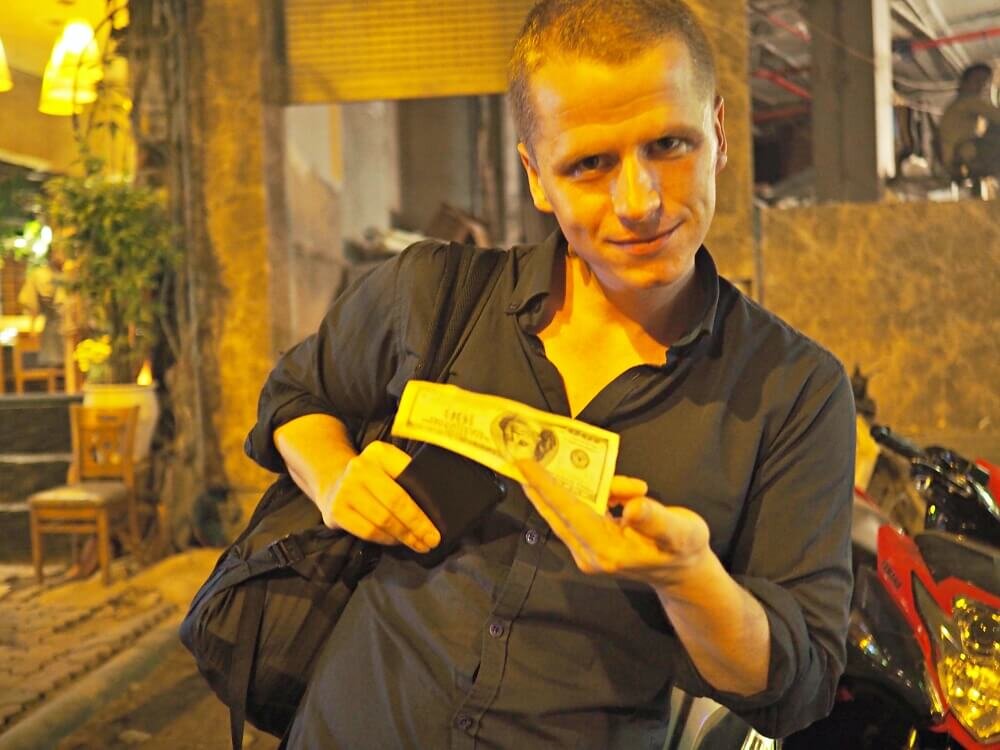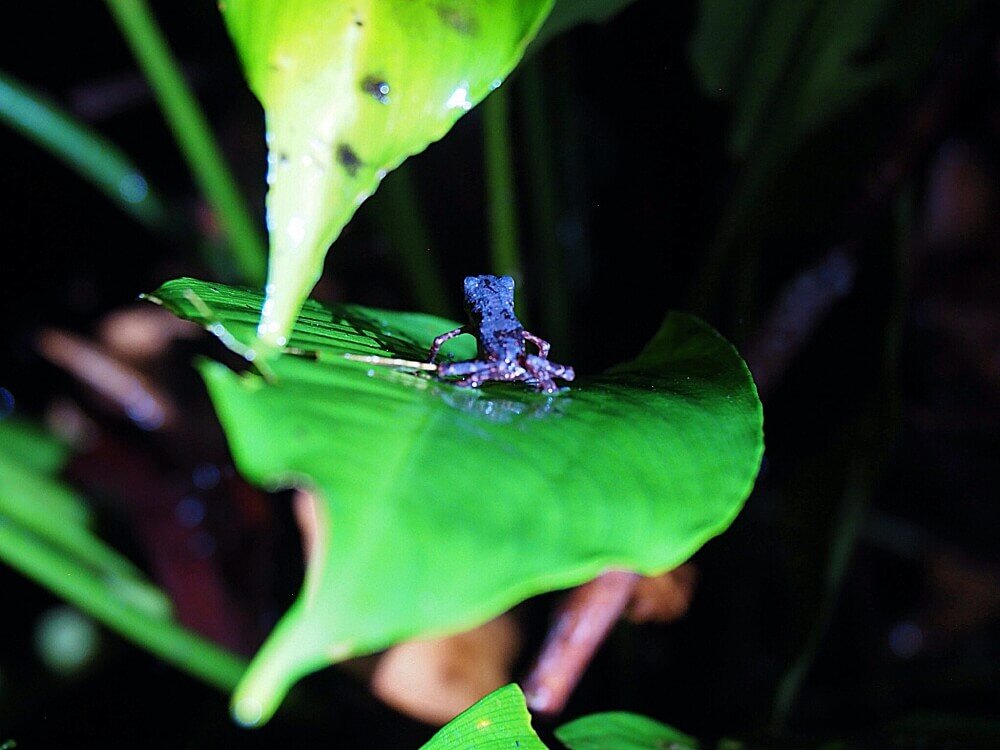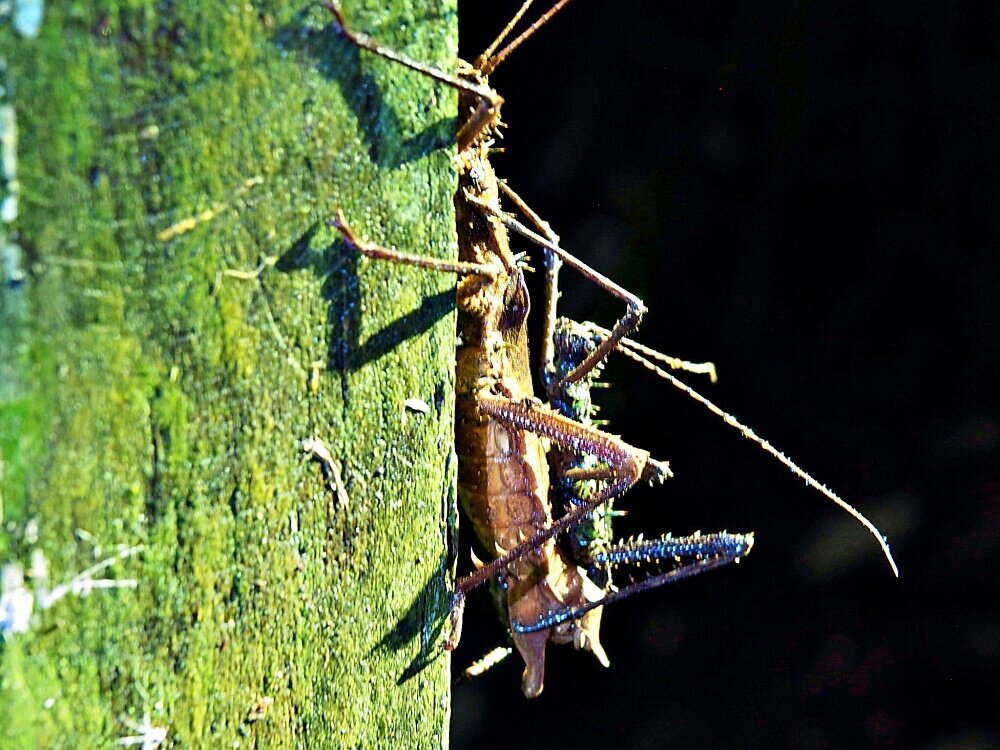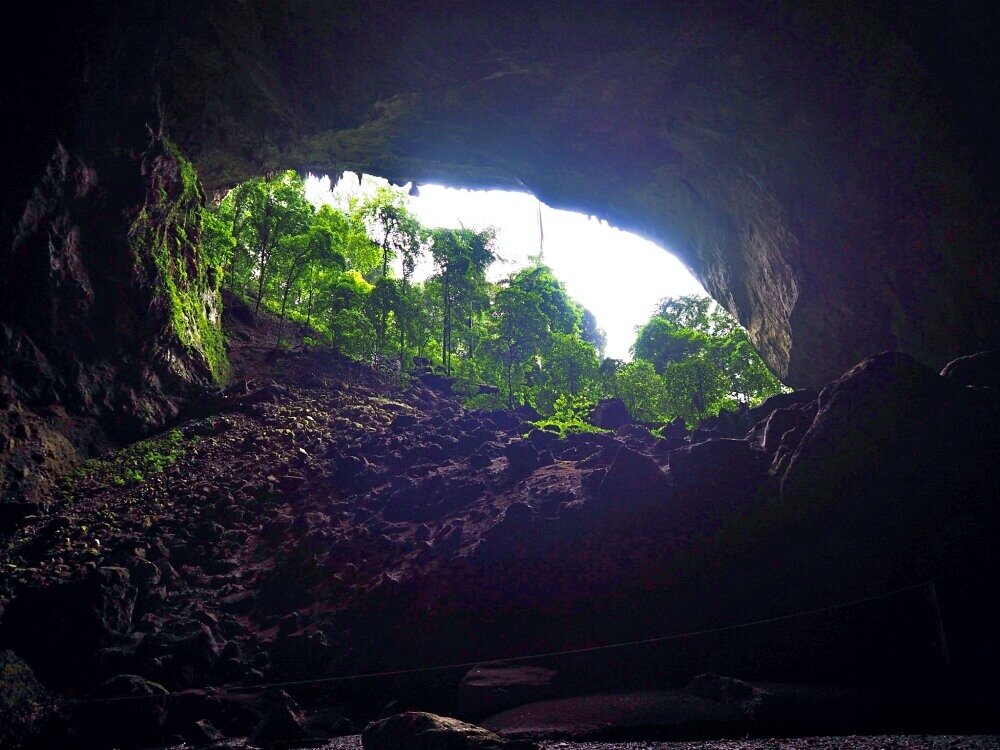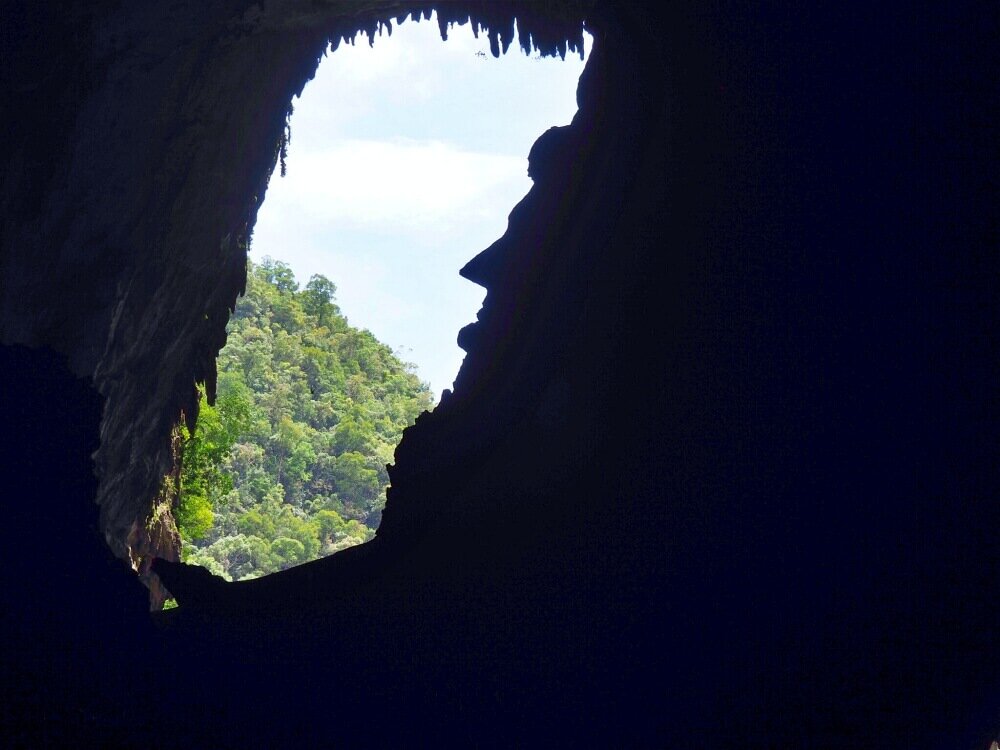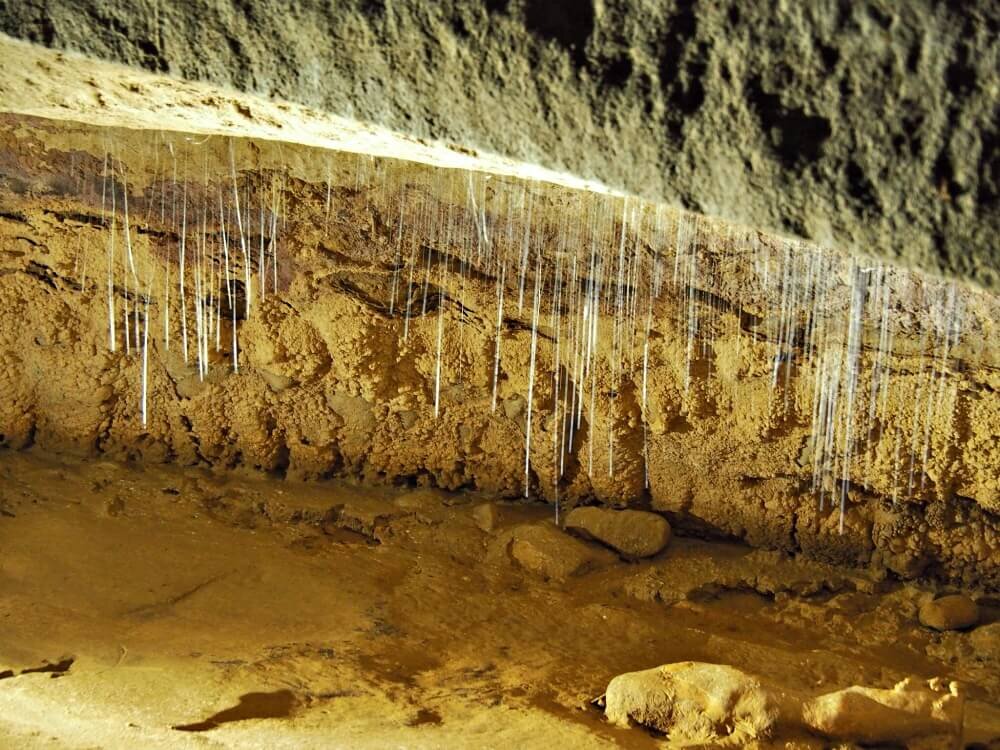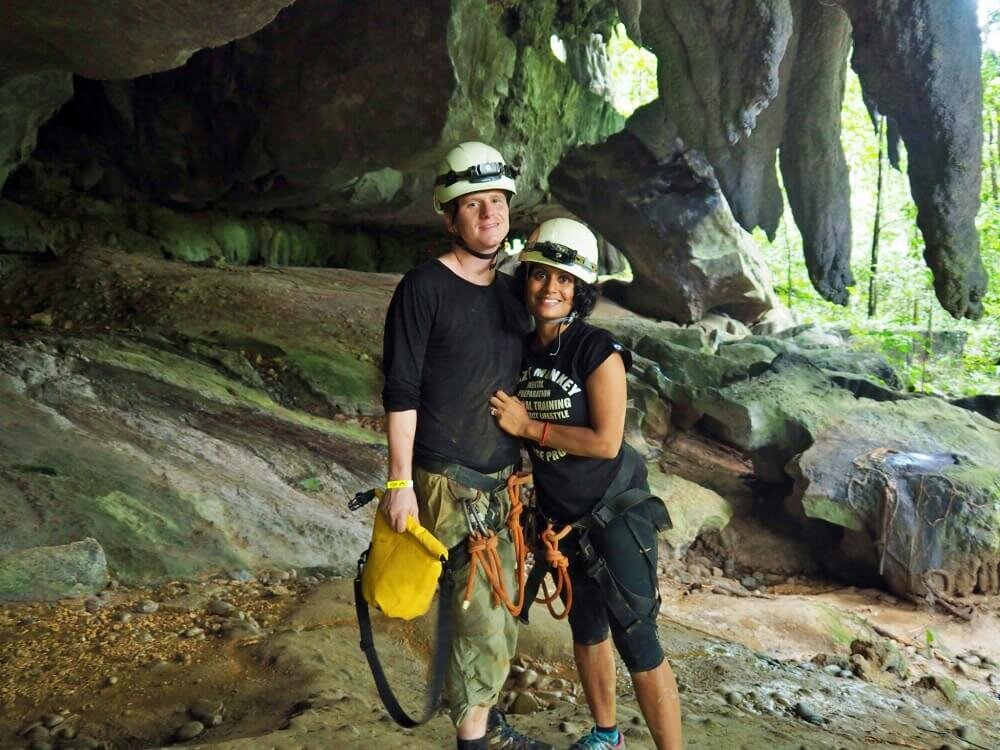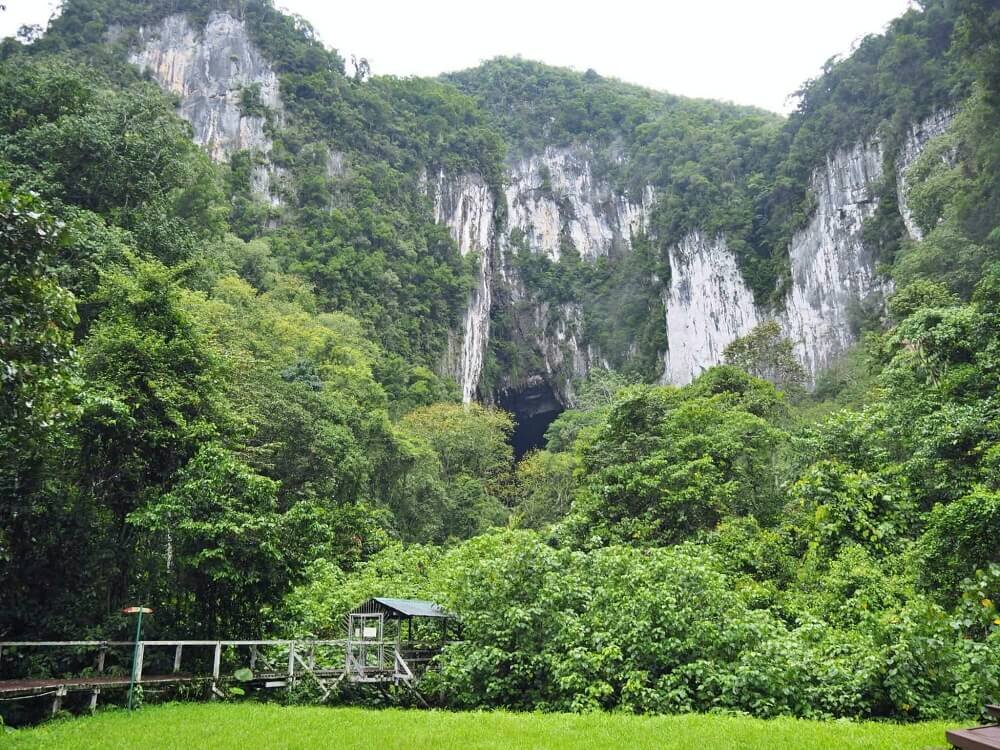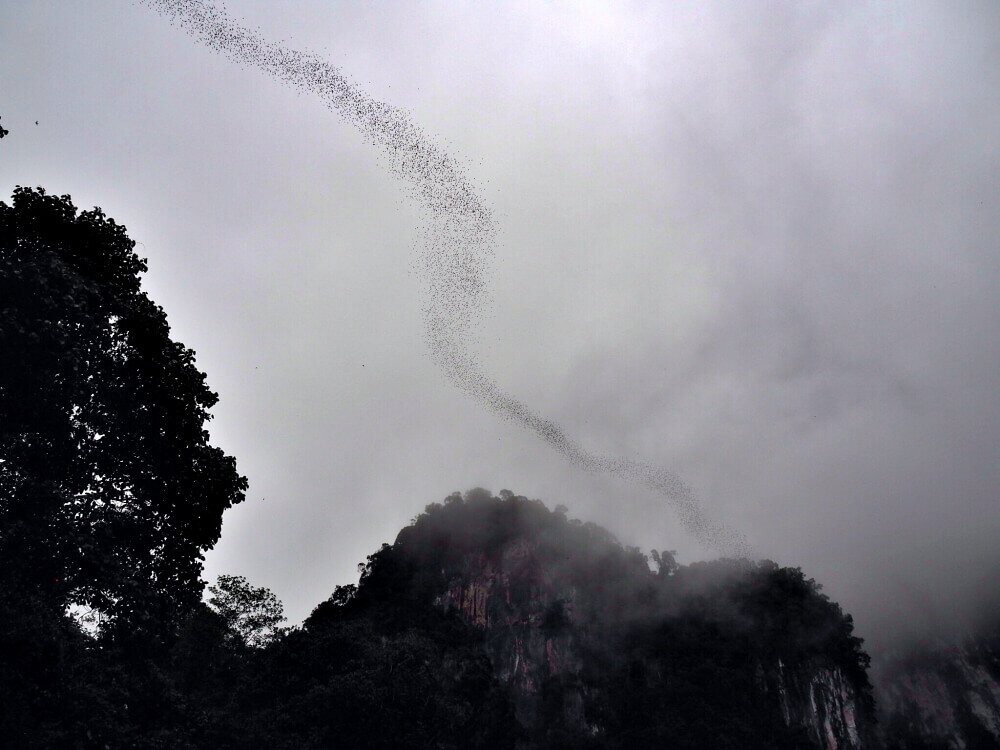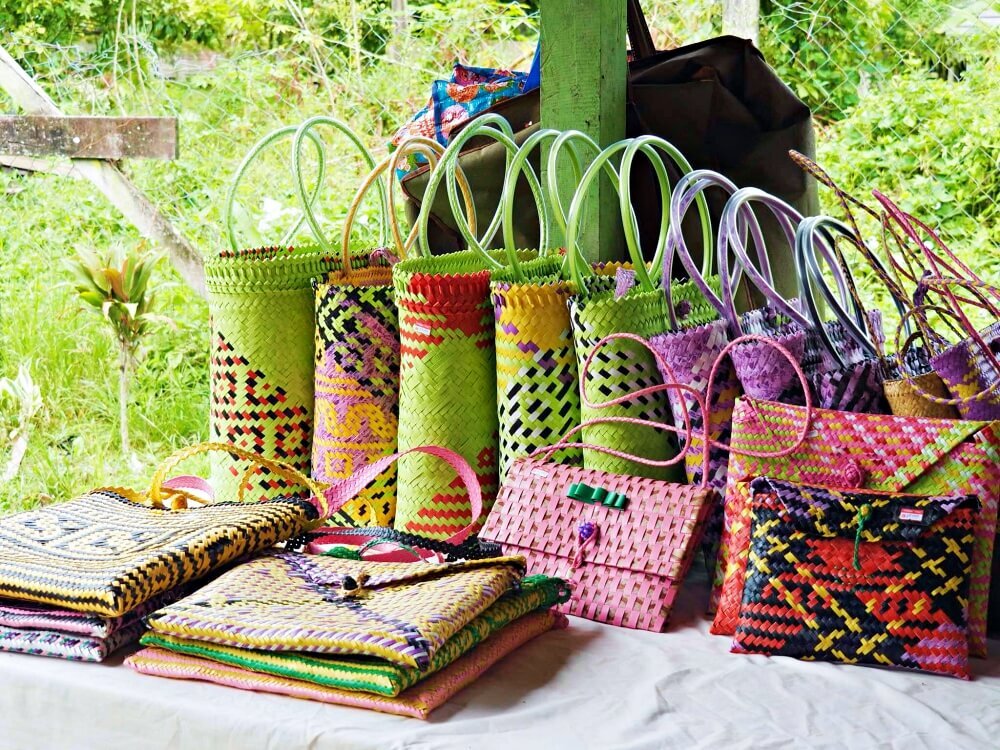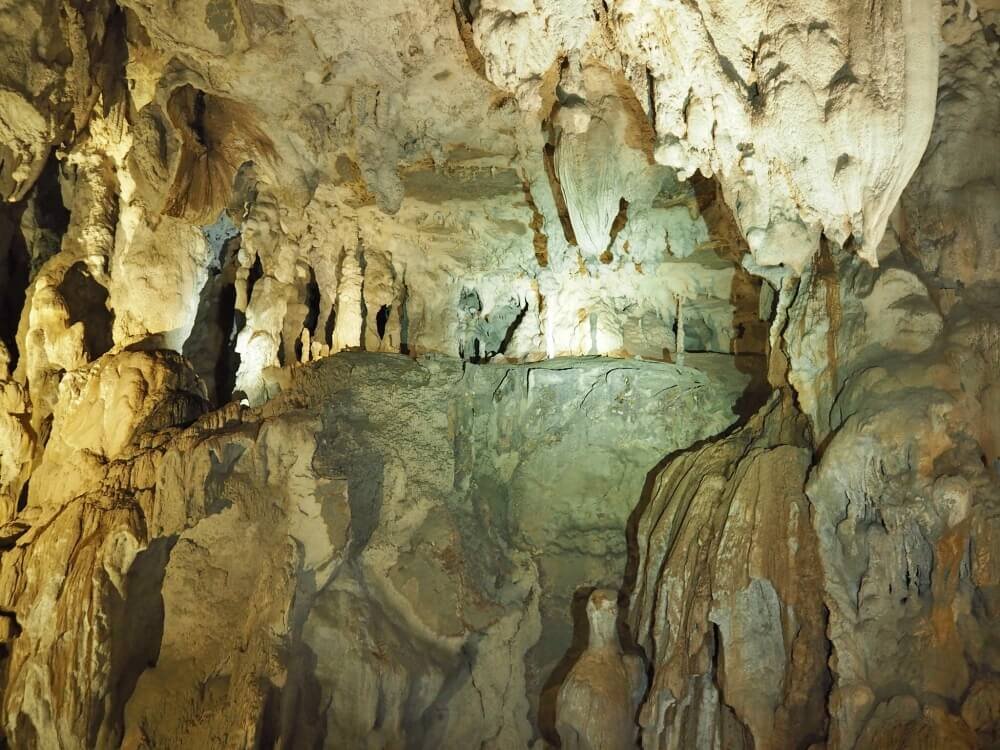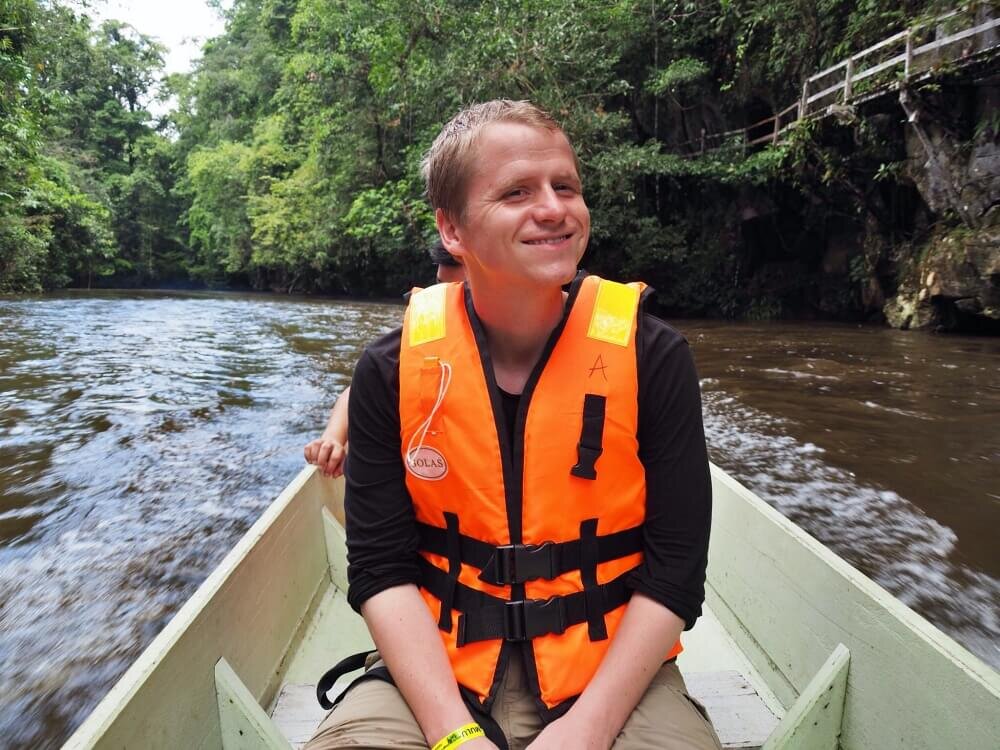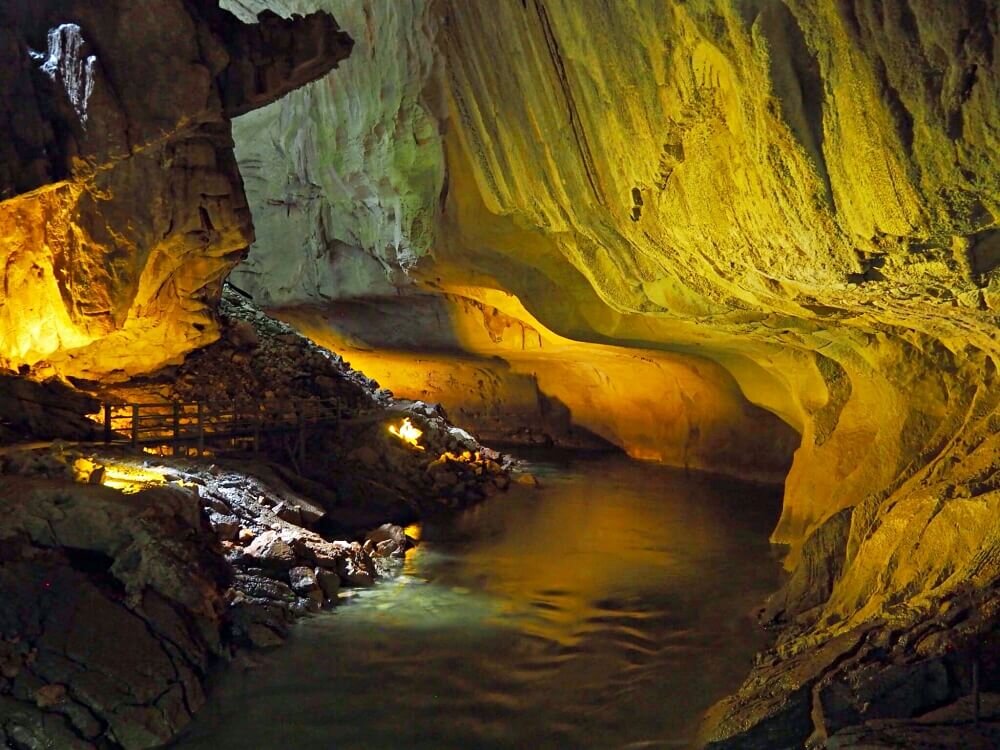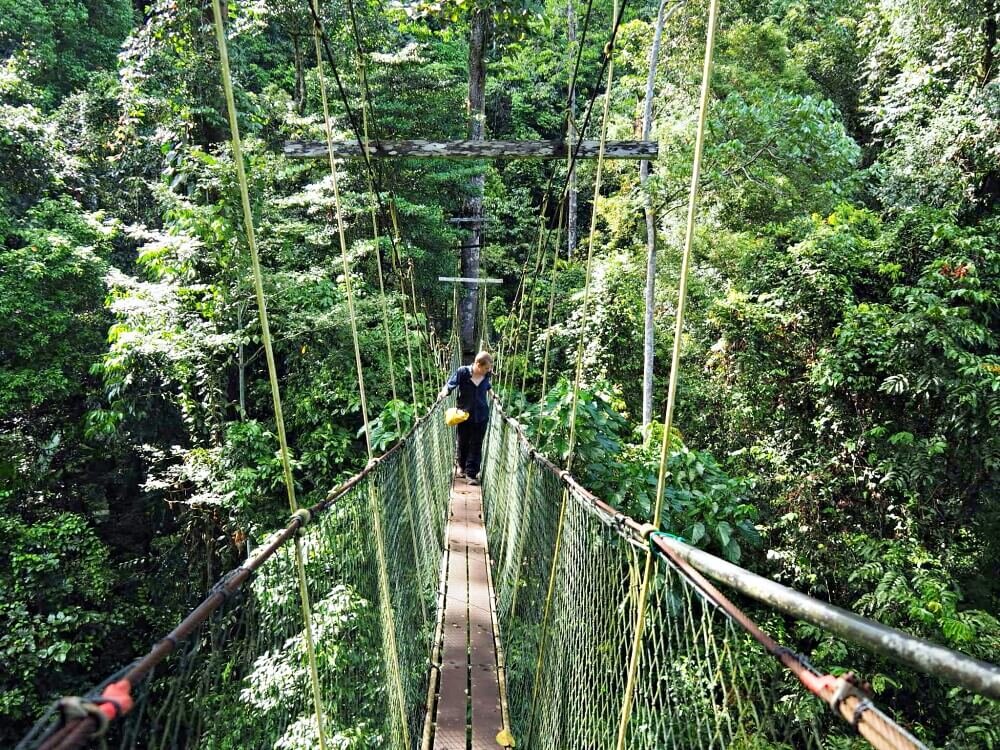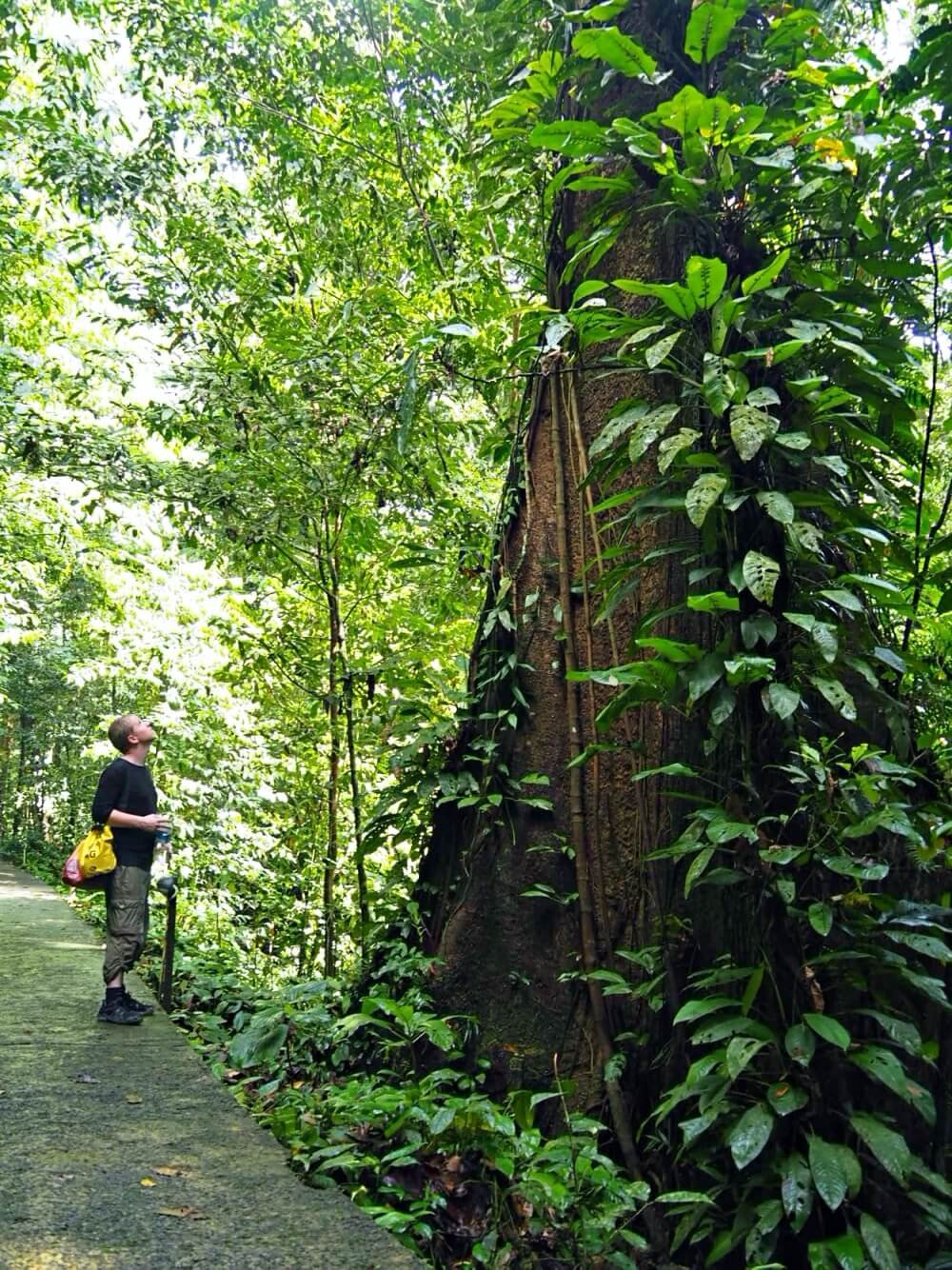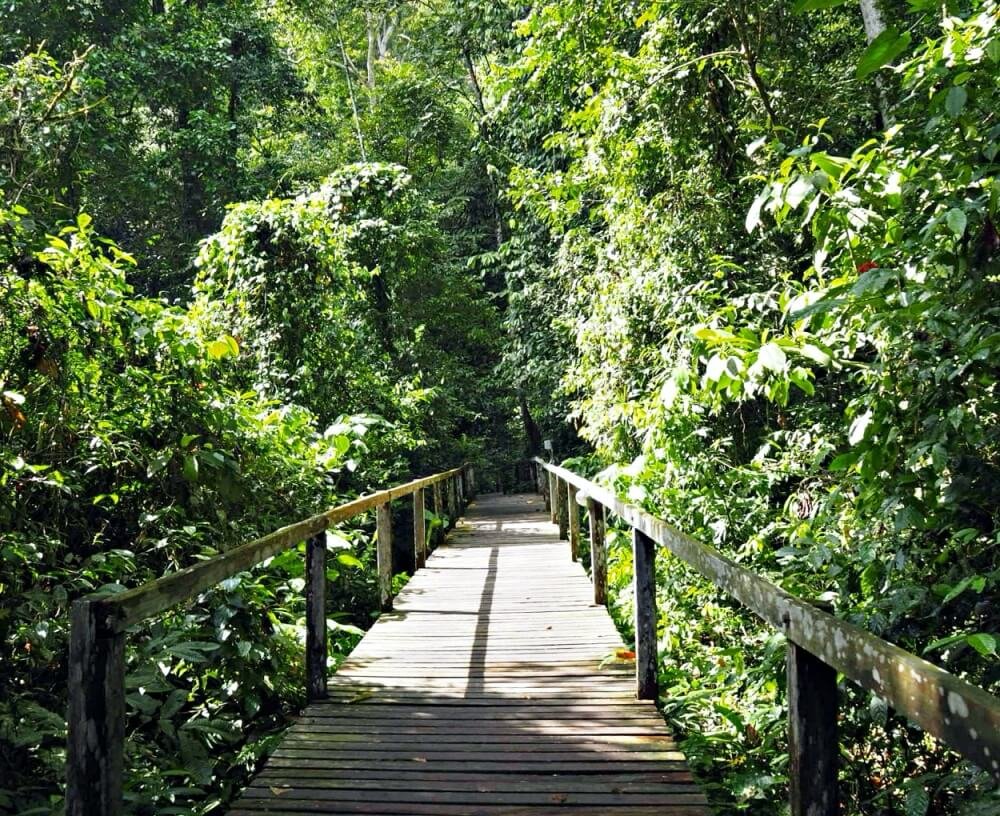What Lies Beneath: A Guide to Visiting Gunung Mulu National Park
Last updated: June 2025
Hurray transparency! This post contains affiliate links for products that we use and love. For more information see our disclosure.
Want to visit Gunung Mulu National Park in Malaysia? Interested in seeing what three million bats flying out of a cave looks like? Our Mulu National Park blog post is a complete guide to planning your epic adventure with everything that you need to know.
This article includes our own 4 night, 5 day itinerary at Mulu (including details about all the activities we did) so you can get a real sense of what a trip to Mulu National Park is like.

Quick Mulu National Park Guide
Travelling to Mulu last minute? Here’s a handy guide to help you make the most of your trip!
🏠 Top places to stay in Mulu:
- Mulu Marriott Resort (jungle luxury with amazing rainforest views!)
- AA Homestay (best budget choice #1)
- Mulu Village (best budget choice #2)
🏠 Best tours & activities in Mulu:
- 5 Days, 4 Nights Mulu Showcaves with Headhunter Trails (includes the Pinnacles!)
- Mulu Headhunter's Trail - 3 Days Trekking & Cultural Experience (jungle trekking & stay in an Iban longhouse)
- 3-Day Adventure in Mulu National Park (covers top attractions & suitable for all ages)
🌤️ When to visit Mulu:
- Mulu has consistent temperatures all year round.
- It's a rainforest, so expect rain whenever you visit!
- July to September is drier - this is peak season so book accommodation and activities well in advance.
🌟 Don't forget:
- Stay connected with an Airalo eSIM!
If you are sneakily trying to plan your visit to Gunung Mulu National Park at work and haven’t got time to read this mega post, just use the links below to get to the section that you want. Don’t say that we don’t love you.
Gunung Mulu National Park
How to Get to Mulu National Park
Best Time to Visit Mulu National Park
Accommodation
What to Pack
Where to Eat
Activities at Gunung Mulu National Park
Unguided Tours
Entry fees and Costs
Mulu Package Tours
As we strap on our harnesses and adjust our carabiners and helmets, Vincent gives me one of those looks. The look that says: “Remind me why we are doing this again?”
In a way, I can see his point. It’s an almost cliched glorious day outside, sun shining, birds chirping…the perfect weather for a relaxing walk and a picnic.
And yet, despite all this beauty above ground, we are about to venture into a dark, cold and wet cave, possibly get soaked through to the bone by freezing water and be surrounded by huge and weird creepy crawlies and piles of bat guano.
It doesn’t sound very appealing. I mean, it’s probably not a place that you’d suggest taking someone on a first date for instance. “Let’s kiss by this pile of bat shit crawling with spiders and cockroaches.” Uh, no.
Why helllloooo there…I am just your friendly neighbourhood spider.
But the truth is, there is a fascinating and stunningly beautiful hidden world beneath our feet. And I love exploring it.
Maybe it’s the fact that I am under 4’11” and I feel an inescapable pull towards living my #BestTroglodyteLife. Or perhaps it is because caves are just so…epic.
From the hidden underground churches in Turkey’s Cappadocia to the ornate caves of Phong Nha Kebang in Vietnam, a caving experience exposes you to some seriously phenomenal sights.
And if that wasn’t enough, it can be quite the workout too. I mean, I really am flexing some cave-related mega-guns right now as I type. I swear.
Marvelling at the gorgeous cave formations at Paradise Cave, Phong Nha Kebang, Vietnam.
This time, our subterranean adventuring was going to take us into the depths of Gunung Mulu National Park in the heart of Malaysian Borneo.
Over the course of this journey I’d see racer snakes, a swarm of bats so thick I initially mistook it for smoke, and caves so beautiful they looked like something out of a Salvador Dali painting. I put on my head torch and smiled at Vincent. I was ready to discover what lay beneath.
Visiting Gunung Mulu National Park
Where is Gunung Mulu National Park located?
Located in the state of Sarawak in East Malaysia, Gunung Mulu National Park is a UNESCO World Heritage site of outstanding natural beauty.
Dominated by three mountains, Gunung Mulu (2,376m), Gunung Api (1,750m) and Gunung Benarat (1,858m), Mulu is one of the most famous national parks of Sarawak, boasting 554 square kilometres of primary rainforest, rivers and jungle streams.
This area of Sarawak is also home to some of Malaysia’s last nomadic tribes as well as a wide range of wildlife, plant and flower species.
The scenery around Mount Mulu National Park
But adventurers from all over the globe often come to visit Mulu for something else: lying beneath the dense jungle is a honeycomb of underground caverns and rivers that make up one of the most extensive limestone cave systems in the world.
Some of Mulu’s caves are even world record breakers: Deer Cave has the world’s second-largest cave passage, whilst the Clearwater Cave System at Mulu is the eighth longest cave in the world.
And if you are still unimpressed by these Mulu caves facts, here’s one that’s sure to get your jaw on the floor: the Sarawak Chamber is the world’s largest natural chamber capable of holding 40 Boeing 747s wingtip to wingtip. Whoa.
How to get to Mulu in Sarawak
Our little plane at Miri Airport.
Flights to Gunung Mulu National Park
There really isn’t anything like flying into Mulu airport. As the tiny ATR 72 plane began its steep descent, I looked out of the window at a scene that could have been straight out of Jurassic Park (cue the theme music in my head).
Below me I could see endless miles of forested mountains and coffee coloured rivers snaking their way across the landscape and out to sea. And then, in the distance, cut into the jungle was the tiniest runway I had ever seen.
We really were in the middle of nowhere, but bizarrely still somewhere with surprisingly good aviation links. Go figure.
The stunning view as you fly down into Mulu National Park. (Albeit with some added plane propellers. Sorry. #shouldhavechosenourseatsearlier).
Flying from Miri to Mulu
The gateway to Mulu National Park is via Miri in North East Sarawak. Flights from Miri to Mulu are operated by the rural air service provider MAS Wings (a subsidiary of Malaysia Airlines) and the direct flight between Miri and Mulu takes just 30 minutes. There are about 15 flights per week on this route.
We flew from Kuala Lumpur directly to Miri, which cost us £20/$28 per person, one way. There are no direct flights from Kuala Lumpur to Mulu.
Airport scenery doesn’t get much better than at Mulu Airport.
Flights from Kuching to Mulu
You can also fly from Kuching in Sarawak to Mulu - this takes a bit longer at 1 hour and 35 minutes and there are seven direct flights per week via this route. This saves time but as it is with Malaysia Airlines, it will be more expensive.
Alternatively, you can fly from Kuching to Miri and then take the direct Miri to Mulu flight that we mentioned above. This is cheaper as you have the option of taking your first flight with Air Asia, with prices starting at £11 ($15) per person.
The return Miri to Kuching flight is also usually super cheap if booked in advance, with prices starting from £5 ($7) with Air Asia.
Flights from Kota Kinabalu to Mulu
Finally, if you are visiting Sabah (and if you haven’t done this already, I’d strongly suggest that it goes on your list of places to visit - think mountain climbing, wild orangutan spotting and a buzzing night life for starters) and want to fly to Mulu from there, you can hop on a flight from Kota Kinabalu which takes 55 minutes. These flights are more infrequent, with only three flights per week operating on this route.
In 2019, the cheapest return flight from Miri to Mulu cost £60 but prices increase over the peak season which runs from June to September. The other routes are a little pricier, with the cheapest flights starting at around £70 return from Kuching and Kota Kinabalu.
The key thing is to book your flights as early as possible. We learned this the hard way: we booked two single flights from Miri to Mulu which cost us 319RM (£60), but our flights from Mulu to Kota Kinabalu cost us 513RM (£97), when they really should have been cheaper.
The local community of Mulu provides reliable and very cheap airport transfers costing 5RM (£0.90) per person to the hotels and lodges around the national park. You can also walk from the airport to your accommodation or the national park if you choose, which takes about 15-20minutes.
For those super adventurers, there is the possibility of hiking to Mulu via the ‘The Headhunters Trail’ which starts from the town of Limbang. The trail is well marked and maintained, however, the area is extremely isolated and the nearest town is very far away so it is recommended that you contact a licensed tour operator to arrange this if you want to take this route. Because going missing in a jungle is totally not cool.
The exciting entrance to Mulu National Park, Borneo…slightly worried about those big wooden boards placed over the planks.
If you do fly in via Miri and have a few hours to kill before your flight to Mulu, take a taxi or order a Grab car into town and get yourself to Khan’s Islamic restaurant. Our flight from Kuala Lumpur was so early that we didn’t have time to get a good breakfast, but we more than made up for it at Khan’s. Think delicious freshly made chappatis and chickpea curry. Yummeh!
Best time to visit Mulu Caves
This is actually a bit of a ‘trick’ title as there is actually no best time to visit Gunung Mulu National Park. Due to its location, Mulu actually has pretty consistent temperatures all year round (unlike the rest of Malaysia which has monsoon seasons).
As it’s a rainforest, there’s a high chance that it will rain during your Mulu trip. If you hate the rain, then the driest months are from July to September but it’s important to remember that the hotter temperatures make any activities in the park more strenuous and tiring.
July to September is the peak season, so if you wish to visit during this time make sure to book all your accommodation and activities way in advance.
Mulu National Park Accommodation
Mulu accommodation ranges from dirt cheap to extremely pricey and luxurious.
We didn’t really have much time to plan our visit to Mulu, so for ease we decided to enquire about accommodation at Mulu National Park Headquarters via their website. That way we figured that we would also be on site for all the activities we wanted to do as well.
Our lovely airy room at Mulu National Park HQ.
There are a variety of accommodation options at the park HQ including double rooms starting at 320RM (£60/$83) per night for two people sharing; longhouse style accommodation with four single beds at 340RM (£64/$88) per night for four people sharing and dormitories costing 58RM (£11/$15) per bed per night.
All rooms include a daily set breakfast. Once you send an enquiry via their website, they will send you an email confirming your booking details and information on how to transfer a 25% deposit to their bank account to secure your accommodation.
You can also pay your deposit by credit card. Just remember to bring proof that you’ve paid the deposit along with you when you check-in so that they can take this amount off your final bill.
We honestly weren’t expecting much from this accommodation (it is in the middle of the jungle after all) and I have to admit that we were pleasantly surprised.
Our room was really spacious, bright, clean and comfortable and had a lovely balcony and decking area outside. The bathroom was also super clean with plenty of hot water - exactly what you need after a day of hiking or adventure caving in Malaysia!
A fancy room at the Mulu Marriott Resort and Spa (picture courtesy of the Marriott website)
For those who desire 5* luxury even in the jungle, surprisingly, there is also something for you.
The Mulu Marriott Resort and Spa is just five minutes down the road from the national park and has all the perks you would expect from a luxury hotel, including lavish cabin-style accommodation on stilts that offers views of the surrounding jungle; bathrooms with huge bathtubs and rain showers; satellite TV and WIFI.
There’s also a spa (did you guess that from the hotel name?), a pool and a breakfast and dinner buffet offering a sumptuous array of dishes that will ensure that you are well fuelled ahead of all your activities.
Of course, all of these perks come at a price: a standard deluxe room (not including breakfast) at the hotel starts at 515RM (£90/$124) per night.
Click here to check out the latest prices of the Mulu Marriott on Booking.com.
Click here to check out the latest prices of the Mulu Marriott on Agoda
For the budget traveller, there are a number of really affordable locally run homestays and backpackers lodges located in Mulu town on the side of the main road leading up to the park HQ. A good list of budget accommodation is available here and some places charge as little as 35RM (£6.50) per night including breakfast.
The AA homestay and Mulu Village homestays are some of the best places to stay outside the national park if you are travelling on a budget.
Be aware that accommodation outside of the park HQ (excluding the Marriott) only have electricity for a few hours each day in the evening so if you are someone who needs a fan or aircon to sleep in hot countries, then this might not be the best option for you.
On the other hand, tire yourself out completely during the day and you might just fall asleep as soon as your head hits the pillow at lights out.
Click here to book the AA homestay on Booking.com.
Click here to book Mulu Village homestay on Booking.com.
Unsure about booking? Check out the reviews for AA Homestay and Mulu Village on Tripadvisor.
What to pack for your Mulu adventure!
Sorry but this stuff is way too impractical to take to Mulu.
The official Mulu website has a basic guide on how to prepare for a trip to Mulu, including typical weather in the national park and some guidance on what to bring with you.
Most people spend at least two to three days at Mulu - we stayed for four nights because we wanted to experience a number of different activities and didn’t want to feel too rushed.
Although you won’t need much in terms of supplies on your trip (unless you are trekking the Pinnacles or doing another multi-day hike), I would recommend packing the following basics:
- Comfortable lightweight clothing that is suitable for hiking and trekking and that you don’t mind getting dirty. I wore basic gym gear on most days and it also dried out quickly: there are often sudden downpours at Mulu, particularly in the afternoon and if you are outside you can quickly become soaked through (this happened to us more than once). Some adventure caving experiences also require you to swim/wade through rivers so quick-dry clothing is essential.
- A raincoat. Again to emphasise, it rains a lot. We had reusable ponchos - you basically want something that isn't too restrictive and that you can climb and walk freely in. Click here for a reusable poncho that keeps you and your backpack dry!
A lightweight and durable daypack. If you plan on doing a number of day hikes and even multi-day hikes, you need a decent bag.
I've written a post on the best daypacks for women - all of these options are water resistant or come with rain covers and so would be suitable for a Mulu park trip.
Nothing like an afternoon downpour…if you are wearing a raincoat, that is.
- Some socks that you can pull over your trousers to stop leeches getting in and sucking your tasty, tasty blood.
A head torch or torchlight. These are particularly useful during night walks, adventure caving experiences and also when the electricity cuts out.
We brought some really crappy ones with us and they fell apart half way through one of our trips (ironically I have a great head torch that I used on a climb of Mount Kinabalu). Don’t be like us: a good head torch is worth the investment. Compare prices for rechargeable head torches here.
(Note: we were provided with proper head torches during the Racer Cave experience, even though the website says you need to bring your own torch. I am not sure why this is.)
- First Aid kit and any personal medication you need. Bring everything from your ibuprofen to your anti-diarrhoea meds with you as there are no chemists in the area. This mini first aid kit is super useful and light to carry - check it out here.
Cash. At Mulu, cash is KING because there are no ATMs or banks. So this is your chance to act like a true playa and bring all your cheese. (But no Benjamins ‘yo, it’s Malaysian ringgit only here).
We brought 800RM to make sure we had more than enough to cover food and other expenses. You can however, pay for your activities at Mulu HQ via credit card.
🔥 Hot tip:
Stay connected on your Mulu adventure with an Airalo eSIM. It makes things so much easier - you no longer have to hunt down a local SIM when you arrive and they have super affordable and generous data packs.
Vincent pretending to be a baller with some fake hundred dollar bills we found on the street in Hanoi, Vietnam.
Comfortable trainers with a good grip or trekking shoes. We wore trainers which worked out fine for us, even in the adventure caving experiences, but mine could have done with a bit more grip. They also dried out quickly after we swam in them.
If you don’t have the right kind of shoes, you can buy a pair of ‘Adidas kampong rubber shoes’ from the Mulu Park shop which are waterproof, have a decent grip and flexible sole that is suitable for climbing.
Some people that we met in Mulu were able to borrow a pair of these shoes from their hosts at their homestays.
- Insect repellant. There are some mozzies at Mulu, but not as many as you would expect. Buy our favourite Incognito insect repellent here. It’s DEET free but just as effective against all the dengue and malaria carrying nasties!
- A dry bag. To keep all your tech equipment bone dry. We bought quite small one from the Mulu shop for 50RM as we realised we would need one to protect our camera. It would be cheaper to buy this elsewhere. There are various sizes available online as well - check out a brilliant dry bag here that comes in various colours and sizes.
- Sun cream Despite being whiter than a milk bottle, Vincent doesn't like wearing suncream because it usually sticky and heavy. So this invisible ultralight sun cream from the Anthelios La Roche Posay is a Godsend. Click here to compare other products from La Roche Posay’s Anthelios sun care range.
- Water bottle. We didn't have a reusable water bottle on this trip and we ended up having to buy plastic bottled water from the restaurant which wasn't great, especially as there are so many great resuable bottles out there now, like this one which has handy reminders for when it is time to guzzle water!
Read: The Best Gifts for Outdoorsy Women - 40 Awesome Gift Ideas for Her (I recommend a lot of things that are useful for a Mulu trip and much more!)
Note - if you are planning to climb the Pinnacles, it is worth reading this guide which tells you what to bring with you (particularly for the camping element of the trip) and what to expect from the experience.
Where to Eat
Mulu Cafe
As we were staying within the national park itself, we ate most of our meals at Mulu Cafe. Our room came with breakfast included - there were pancakes and traditional Malaysian roti canai with dhal as well as Western breakfast staples such as eggs and toast.
The menu options for lunch and dinner were fairly reasonably priced (although still twice what you’d pay anywhere else in Malaysia) and very tasty.
The menu at Mulu Cafe.
There are also great choices for vegetarians: I particularly liked ordering some of the vegetable side dishes for my main course including the vegetable coconut curry and paku jungle fern with ginger and garlic. Yums.
Be aware that during bad weather, supplies sometimes don’t reach the park and so they can run out of certain ingredients: when we were there they didn’t have bananas for several days, much to Vincent’s dismay as he loves a good banana smoothie.
Good Luck Cave-Fe Mulu
If you want to try something a bit different and cheaper, just outside the park is Good Luck Cave-fe Mulu. They serve a variety of Malaysian dishes such as laksa, tom-yum soup, nasi goreng and sweet and sour fish with rice for between 10-18RM. There’s also a number of Western food options and they serve beer as well (although it is expensive!).
Mulu Marriott
If ca$h monies are no barrier, then you can opt for something fancier at the Mulu Marriott - they have an a la carte restaurant and a wide selection of dishes, although I personally don’t think it is great for vegetarians (the Mulu Park HQ restaurant is MUCH better). It’s obviously more expensive here so don’t forget your wallet.
Cafe Tenguloh
Finally the cheap and cheerful cafe Tenguloh, located opposite the Marriott serves up cheeseburgers, nasi goreng, BBQ chicken, cheap beer and some vegetarian delights as well. The food is nothing to write home about but it is cheap.
Supermarkets
You can purchase water and snacks at the Mulu Shop, plus any other essentials like rubber trekking shoes and dry bags. Prices are expensive.
The local supermarket, SG Pala Canteen down the road from the Marriott, is the place to go if you need to buy groceries in preparation for the Pinnacles tour or multi-day hikes. It’s a small place so don’t expect a Tesco/Walmart selection!
Activities at Mulu
The reception area at Gunung Mulu National Park, Malaysia
You’ve arrived! Now the fun really starts - you simply have to choose what you want to do and then, well, do it.
We booked most of our Gunung Mulu National Park tours when we arrived at the Park HQ apart from two that we were advised to book in advance via email due to their popularity - the Night Walk and the Garden of Eden cave experience.
Activities book up quickly, so I recommend that organising your itinerary at Mulu should be your priority as soon as you arrive, unless you have pre-booked all your experiences with a separate tour operator.
Prefer a tour? Here are the best organised tours of Gunung Mulu National Park:
3 Days 2 Nights Unesco World Heritage Mulu 4 Showcaves
3-Day Adventure in Mulu National Park
Mulu Headhunter's Trail - 3 Days Trekking & Cultural Experience
4 Days 3 Nights Mulu 4 Showcaves with Pinnacles
5 Days 4 Nights Mulu Showcaves with Headhunter Trails
You can read more about these tours further on in this post.
Gunung Mulu National Park activities are divided into a number of categories:
Showcaves - these are easily accessible caves that still need to be visited with a guide, but include boarded walkways and some lighting. The Deer and Lang Caves, Clearwater Cave and Cave of the Winds are the four show caves of Gunung Mulu National Park.
Adventure Caves - these are guided experiences in the Gunung Mulu National Park caves. These activities require a certain level of physical fitness and you are equipped with a hard hat, ropes and torchlights. The experiences vary from beginner to advanced level and include some climbing, scrambling, hiking and swimming.
Trekking and Hiking - these include a guided night walk, a trekking and overnight camping experience, jungle trekking and Mulu canopy walk which is one of the longest tree-based canopy walks in the world.
Extreme Adventures - this includes the Pinnacles trek and the trek to Gunung Mulu Summit.
There are also a number of unguided and well-signposted walks that you can do yourself around Mulu - the Park HQ will give you a map of the park when you book your activities that show you the various unguided walking trails and routes.
You can also take a longboat ride down the river to visit indigenous settlements and nearby waterfalls.
Our Gunung Mulu National Park map - we were given this after we booked our activities and they helpfully wrote our itinerary along the side!
After a bit of discussion, (yes, I promise there was discussion, I didn’t decide it ALL) we decided to book an adventure caving experience, a trek, a night walk, a trip to some of the other showcaves and the canopy experience.
And if we could fit in some of our own walks and experiences, we’d do that too! It was that go-hard or go-home mentality: we were finally here, so we might as well pack in as much as we could (and also as much as our budget would allow).
Note: sometimes activities get cancelled due to heavy rainfall at Mulu. The guides will assess the weather before each activity and inform you whether it is safe to go ahead.
Because tours can get cancelled at short notice, I would recommend that you add at least one buffer day on to your trip, so you can re-book an activity if necessary.
And so without further ado, here’s our itinerary over our 4 night, 5 day trip at Mulu National Park.
Day 1
The Night Walk - For You Night Owls
Duration: 1-2 hours
Are you the kind of person who wants to know what kind of creepy crawlies lurk about once dusk has fallen? Or perhaps you see a small, dark hole and wonder what lives inside it? Then the night walk experience is for you.
It was just after 7pm when we gathered at the meeting point with our guide for our first activity at Mulu. It had rained and the rainforest was filled with the cacophony of buzzing insects.
After checking that we all had the right footwear (the main paths around the park are all boarded but can become really slippery after the rain) and advising us not to wear insect repellant as it scares off the wildlife (who knew?) we set off.
The night walk encompasses a 1.5km circular route around the park. Our guide was extremely knowledgeable and as I expected, very observant, pointing out all sorts of hairy caterpillars, frogs and insects that I would have otherwise simply walked past.
The biggest surprise was seeing a stick insect the length of my forearm wandering nonchalantly about (I had no idea that they grew to be that large).
There were also a number of mating pairs of stick insects, so I learned that April is perhaps the month that they like to get jiggy with it. Or maybe they are at it all the time. Horny devils.
Na na na na na na, na na na na na…stick insect sexy time
The night walk is a great introduction to some of the creatures that inhabit Mulu National Park and also a good way to get familiar with the various walking trails you can do by yourself.
Pro-tip: use a camera with a flash on the night walk if you want to get really good pictures of the insects and animals that you see. I didn’t do this and I wished that I had. I didn’t repeat this mistake again when I went on another night walk in Kinabatangan.
Day 2
Garden of Eden Valley Walk
The Garden of Eden in Gunung Mulu National Park, Malaysia
Duration: Full day usually finishing around 5pm
This intermediate level tour also includes a visit to the Deer and Lang caves - as it’s a full day tour, you are advised to bring your own lunch and so we ordered a packed lunch from the Mulu Cafe while we were having our breakfast.
We started off at 9.30am on a 12km round trip that took us through the jungle and over rivers along a boarded walkway. There were eight of us in our group, including one guy, who I estimated to be in his early twenties, who was dressed in full army fatigues. This made me worry about exactly what kind of trek I had signed us up for.
Deer Cave
The first stop after a 45 minute walk was Deer Cave, which contains the world’s second largest cave passage - 174 metres wide and 122 metres high. (It used to hold the world record but after a cave-off with Vietnam’s Hang Sơn Đoòng in 2009, was relegated to second place.)
The jungle boardwalk leading to Deer Cave.
Now, if the thought of venturing into any kind of cave makes you feel slightly claustrophobic, let me reassure you, Deer Cave is absolutely MAHOOSIVE.
Once inside, I craned my neck to see if I could glimpse anything remotely resembling the ceiling of the cave and failed miserably. The space inside Deer Cave is supposedly five times the size of St Paul’s Cathedral. So…pretty big then?
It really is a big cave - you can see this from the outside.
The mouth of Deer Cave, Gung Mulu National Park.
The Deer Cave in Mulu has 800 metres of boarded walkways inside it, which makes it quite easy to explore. As we wandered through, we could hear the gentle squeaking of the bats that were sleepily clinging to the vaulted cave roof above us.
The largest part of the cave is actually home to three million bats from 12 different species (higher than any other single cave in the world) as well as a large number of swiftlets.
A beautiful view…and lots of bat poo
The bat residents have certainly made themselves at home, by basically pooing all over the place. The cave floor, handrails and steps were pretty much all covered in bat guano - in some areas of the cave the guano was literally metres high.
As a result, Deer Cave has quite a pungent, ammonia-like smell, so if you aren’t a fan of strong smells, it might be advisable to cover your nose with a scarf.
Our guide told us to shine our torch onto some of the piles of guano and when we did, it looked as though it was moving. On closer examination we could just about see hundreds of cockroaches and spiders scuttling across it. Lovely.
The mammoth inside of Deer Cave, Mulu.
I was taking my time, wandering along slowly and taking photos of absolutely everything. Our guide however, seemed to want to rush us through (something I find highly annoying on tours) and telling us that we could take photos later.
Me being me, I ignored this and carried on as I was and seemingly pissed off some members of the group in the process. One girl hissed “they keep stopping to take photos” and then sped off with her friend at high speed. I didn’t really understand the rush - the cave or the jungle wasn’t going to be going anywhere.
Water streaming down from the ceiling.
And how could you not linger? The cathedral-like inside of Deer Cave is truly magnificent: sunlight streams into parts of the main chamber and in the widest part of the cave I felt like I was standing in the depths of a weird kind of valley.
At a certain point, we turned around so we could see another of Deer Cave’s distinguishing (one could say, ‘presidential’) features: the silhouette of jutting rocks towards the mouth of the cave looks like Abraham Lincoln!
Yo, Pres!
Our group had gone on ahead and so a few shutter clicks later, we sped after them. As we rounded a corner, the beautiful ‘Garden of Eden’ came into view and we found our group standing in a hushed silence. There was clearly time to take photos now.
Ahead, we could see shafts of daylight and rich, verdant vegetation: a stark contrast to the darkness within the cave. This green oasis is thought to have been the result of a massive sinkhole, which let in enough light to enable plants to thrive.
In keeping with the biblical theme, our guide then also pointed out the ‘Adam and Eve showers’ on the roof of the cave which spout columns of water 30 metres onto the riverbed below.
The Garden of Eden.
A jungle trek and some pretty waterfalls
The regular tour of Deer Cave would usually end here, but not for us. Our guide explained to us that we would have to cross the Eden river, which flows right near the Garden of Eden and into parts of Deer Cave.
The water “was only chest high”, he said, so it would basically be wading through the river to get to the other side, where we would begin our jungle trek. “Carry your backpacks above your heads” he advised, “so that your cameras, dry clothes and lunch doesn’t get wet”.
READ NEXT: Interested in other jungle trekking experiences? Check out our guide to trekking in Luang Namtha in Northern Laos!
I looked at Vincent. Only chest high? I already knew that chest height on a normal person was going to be right over the top of my head. Vincent packed our camera and lunches into our dry bag and then everyone started to wade through. Apart from me.
I swam and got out on the other side soaking from head to foot. Ah, the pitfalls of being an under-height human.
A beautiful waterfall on the Garden of Eden trek in Mulu caves national park, Sarawak
Once we had crossed the river, we followed it for another hour or so, trekking through the jungle uphill. As we walked, I noticed a leech had decided to make love to my leg, so I stopped and flicked it off.
As the terrain became steeper, some of our fellow group members were starting to fall behind, panting and red-faced. I guess it’s pretty easy to storm off in a huff when the terrain is flat eh?
Our walk ended at some rock pools filed with crystal clear water and a small but picturesque waterfall. Here we were able to take a one hour break to have some lunch and a swim.
My cheese and tomato toastie had survived the journey but Vincent’s pitta filled with marinated chicken and sweet chilli sauce had seen better days.
The moral of this story is that it is best to take a basic sandwich or toastie with you for lunch because anything else will basically steam up, get soggy and become totally rank.
After lunch, and seeing as we were already wet, we decided to have a paddle about in the water with our clothes on (trainers included). We’d worked up quite a sweat during our humid jungle walk so being able to take a dip in the refreshingly cool water was amazing.
As we were splashing around, we heard a commotion. We turned around to see the guy in army fatigues (and now wearing some swimming shorts) becoming increasingly hysterical as he had discovered a leech in his armpit. His dad asked him to hold still while he removed the offending creature.
Cue lots of shouting and some actual tears.
Lang Cave
After lunch our guide led us back through the jungle and Deer Cave but our Mulu caves tour wasn’t over yet! Instead, we were taken to Lang Cave, the smallest cave in Mulu National Park and famous for its beautiful and ornate rock formations.
Discovered in 1977 by a local Berawan man named Lang Belarek, Lang Cave showcases the impact of water eroding limestone rock over thousands of years.
Rolling waves were sculpted into the ceiling of the cave (for some reason they reminded me of filo pastry on a pie) and in one area the stalactites and stalagmites even resembled jellyfish!
The hall of jellyfish.
In some areas you could see the process happening (albeit incredibly slowly) before your eyes, as water dripped off stalactites and onto the ground.
Lang Cave is also home to cave worms, which dangle sticky, translucent threads (basically like a spiderweb) from the rock in order to catch small insects.
These silken threads looked so delicate and beautiful when they caught the light but I imagine they are pretty deadly for any insect that is unfortunate enough to encounter them.
Like Deer Cave, Lang Cave has a boardwalk and given its small size, our exploration of Lang Cave only took about 30 minutes. Our guide then left us at the Bat Observatory from which we could view the bat exodus.
By this point we were kind of sick of being in wet clothes and so we decided to walk back to our room, get showered and changed and grab some dinner. We’d see the bat exodus tomorrow, after all, they have to always come out and search for food don’t they?
This however, is an extremely risky strategy - we didn’t realise that the bat exodus is actually weather dependent (don’t you just love nature?).
Later that evening we actually went outside the park HQ and we saw the bat exodus from a distance. The weather was fine and dry and to us it looked like a huge cloud of smoke spiralling across the sky. Very cool!
The walk back from the Bat Observatory is also a great opportunity for more wild-life spotting, even if you don’t have a guide with you. We saw colourful millipedes, scores of butterflies and brightly coloured lizards so make sure to keep your eyes peeled!
Hello millipede my old friend.
Day 3
Racer Cave and Bat Exodus
Duration: 4 hours (Racer Cave). The bat exodus usually starts after 5pm and basically lasts as long as the bats want to come out of the cave.
Racer Cave
The next day we were up bright and early for our first proper adventure caving experience. I decided that I’d wear the same still wet clothes from the day before as I figured I was just going to get dirty anyway (don’t judge me, please).
A short boat ride down the river later and we arrived at the entrance to the Racer Cave.
Our guide then gave us our harnesses, helmets and head torches and made sure that we were securely strapped in. After a short safety briefing and an explanation on how to use our equipment, we were ready!
Equipment at the ready and wearing the same clothes as the day before (remember not to judge!)
The Racer Cave experience is ideal for anyone who wants to try adventure caving for the first time. We had to climb up ropes, abseil down steep slopes and crawl and squeeze ourselves into narrow passageways, which basically gave us a taste of what a proper caving or ‘spelunking’ experience would be like.
The slightly scary entrance to Racer Cave
There were moments when I wondered whether I’d really be able to squeeze through a certain gap or pull myself up a sheer edge and then when I did it, the buzz of joy I got was incredible.
This is definitely an experience that is worth getting dirty for - by the end I was damp with sweat and my legs and hands were smeared in mud but the physical exertion was exhilarating.
Muddy but happy.
The cave gets its name from the Racer snakes that live in the cave’s nooks and crannies, waiting to pounce on unsuspecting bats and swiftlets.
Our guide showed us a small recess where he knew Racer snakes were likely to be and each member of our group went in to see if they could spot them.
A Racer Snake (image courtesy of Mulu National Park website)
When it was our turn, we shone our head torches up to the ledge and they were actually moving, darting in and out as though they were trying to catch something!
I’ve only ever seen this in nature documentaries, so to see it happen in real life was…well, one of those bucket list things. (Vincent said they were so active because they thought I was a small, brown, bat. Nice.)
You’ve probably already guessed that Racer Snakes aren’t the only occupants of this cave. I actually lost count of the number of hand-sized poisonous spiders the guide pointed out, along with millipedes, scorpions, cockroaches and bats.
You definitely need to be careful where you put your hands, because the spiders are seriously huge.
One of the massive cave spiders (image courtesy of Mulu National Park website)
The only light in Racer Cave came from our head torches. There were no proper paths and to my untrained eye, no distinguishing features that would enable me to work out how to get back to the entrance without our guide.
I did ask the guide whether anyone had ever got lost inside this cave and he said it had happened once with a group led by an inexperienced guide. Yikes.
I could see how it could happen - everywhere looked the same to me and this was despite the fact that I was wearing a head torch!
At one point our guide said that he wanted us to experience the real darkness of the cave and asked us to shut off our torches. It was absolutely pitch black - I couldn’t see Vincent and he was standing next to me! (And normally, I can see that shining white skin anywhere…)
Inside Racer Cave (image taken from the Mulu Park website).
This experience does require you to be reasonably physically fit and to have some upper body strength as you will be pulling yourself up and down ropes quite a lot as well as clambering over rocks.
You should also ideally wear shoes with a good grip as it is quite slippery and muddy inside. I could have made a better choice than my 5 year old Nike trainers.
If visiting Mulu National Park is all about adventure caving for you, be sure to check out the other intermediate and advanced level caving experiences in the park.
For advanced level tours in Gunung Mulu caves, you must demonstrate one of the following:
1) Be a current member of an internationally recognized speleological society or caving group.
2) Show previous caving experience: this must be an expedition of at least 3 hours in duration in a wild cave that has no lighting or pathways. The Mulu Park manager will need to approve any written evidence - this should include the caves visited, date, location and any technical skills e.g. climbing ropes, swimming, crawling through tight spaces.
3) Complete an intermediate adventure caving tour to show the guide your abilities. If approved, an advanced-level caving tour can be organised for the following day.
Bat Exodus
The boat dropped us back to the park HQ around 1pm and after a much needed shower and some lunch, we enjoyed a bit of downtime and a nap before heading out to the Bat Observatory.
We actually managed to do a bit more nature spotting near our room - there is literally wildlife everywhere.
What had started off as a bright, sunny day had rapidly changed to a drizzly, grey afternoon. We set off at 3.45pm on the walk to the Bat Observatory, which basically follows the same jungle route as to the Deer Cave, hoping that the spattering sound of rain on the leaves of the trees above us would eventually ease off.
The observatory is basically a small amphitheatre-like area that has been set up for people to watch the bats flying out of Deer Cave.
There is a small shop where you can buy some snacks and drinks (including beer) so that you are sufficiently fed and watered while you wait for the bats. It’s basically like a nature cinema.
The view from the Bat Observatory.
Whilst the amphitheatre area is at the mercy of the elements, there is also another section that is covered should the heavens open while you wait for the bats to appear.
As it was raining when we arrived, we went in here and got some drinks and then had a look at the posters about the different species of bats that live in Deer Cave.
Whilst 12 species of bats live in Deer Cave, the biggest colony are the Wrinkled-Lipped bats whose population is estimated to be between 2.5 and 3.5 million. These little guys aren’t the prettiest but they do look kind of cute - sort of like a tiny squashed pig with wings.
The cute but kinda ugly wrinkled lip bat. (Image source here).
They also have extremely voracious appetites: a single bat will eat 300 or more flying insects each night, with the total number of insects consumed by the bat population running into hundreds of tonnes each year. (This is why you can walk around in the jungle in Mulu without wearing any insect repellant and not be munched to death by mozzies.)
However, being able to see the bat exodus is a hit-and-miss affair. Bats know that there will be fewer insects flying around on rainy days and so, much like myself, they don’t venture out in wet weather. I hear you bats, I really do. Better to have a cup of tea and watch something on Netflix.
Was a cutout of a bat the closest we were ever going to get?
Looking up through the drizzle at the grey sky, I wasn’t feeling very hopeful. This was something that I had wanted to see ever since I first saw it on David Attenborough’s Planet Earth but it didn’t seem very likely that they would be out today, especially as they had been out hunting the day before.
I was also already having to manage my expectations: when I first heard about the bat exodus I thought bats would be flying around my head, getting caught in my hair and everything. I was kind of looking forward to that.
When I got there I realised that it was actually going to take place at quite a distance above us. (Yes, I am an idiot, I know.)
What I thought the bat exodus might look like.
At about 5.00pm the rain had eased off slightly and so we went to sit outside. Suddenly someone pointed up - against the grey clouds there was a sudden thin wisp of what looked like black smoke, winding its way across the sky. But of course, it wasn’t smoke. It was thousands of bats.
The first bats to leave Deer Cave and some Bat Hawks hoping to catch a tasty meal.
We waited a couple of minutes and then another swarm burst out of the cave, spiralling high into the air and swirling across the sky like a snake.
After that a cloud of bats would stream out of the cave every few minutes, corkscrewing into the sky before heading out over the jungle for their nightly hunt. And with each stream of bats there was also a sound: a low, deep whirring of all those tiny wings beating through the air.
Bats flying out of Deer Cave in the evening at Mulu, Malaysia
And then at about 5.45pm it was as though the remaining bats in Deer Cave, having seen their friends give it the okay, had mustered up the courage to go hunting in the drizzle.
For the next 30 minutes we watched an endless stream of bats leave the cave in a thick swarm, weaving across the sky and disappearing into the forest. Alongside the stream were hunting Bat Hawks, flying alongside the millions of bats and waiting to pick off some of the unlucky ones.
By 6.30pm there were a few final stragglers leaving the cave. It was now just us and a handful of people left at the observatory and eventually we started our walk back through the jungle.
Both of us were quiet - watching the bat exodus was an amazing experience and we resolved to come back the next night to see it all over again, if nature would let us be so lucky.
As we walked, the sounds of cicadas, crickets and other buzzing insects filled our ears and every now and then a hunting bat flew past our heads. It seemed like I had got my wish after all.
Day 4
Clearwater Cave and Cave of the Winds
Duration: 4 hours
After two very adventurous days we were ready to take things a bit easier and so we decided to make a visit to the Clearwater and Wind Caves. This didn’t mean that we got a lie-in though!
The day started with a lovely longboat ride along the Melinau River. Whilst you can walk 4km along a nature trail to reach these caves, we felt like we had done plenty of strenuous activity already and so we opted for the boat ride.
Plus, a longboat ride is just so much fun - think cool breeze in your hair and lots of stunning scenery.
A lovely unflattering selfie showing my excited face on the longboat
I mean, where else are you going to get on a longboat and travel down a river in the middle of the jungle? Might as well do it here!
Batu Bungan Market
Our first stop on this tour was a visit to a Penan longhouse and a market at Batu Bungan.
Now, it’s usually this type of visit that puts me off going on tours at all: I don’t like being herded around carpet shops or jewellers or spice markets (as a result of bad memories from package holiday excursions, perhaps).
However, our guide just left us to wander about as we pleased, which was fine and dandy with me.
At this market people were selling traditional Penan handicrafts (jewellery, woven baskets and mats and blow pipes) and it was quite interesting to see the items being made. You could also try your hand at shooting a traditional blow pipe, if that is your sort of thing.
The market is basically a way of helping Penan people to earn a little income, because sadly their traditional nomadic way of life has been destroyed due to large scale commercial logging and the building of palm oil plantations in Sarawak.
Wind Cave
After half an hour at the market we hopped back on the boat and headed off to visit the Cave of the Winds or ‘Wind Cave’ for short. From the boat we walked up a sloping boardwalk and some concrete steps to get to the mouth of this cave.
Wind Cave gets its name from the cool breeze that constantly flows through it and which offered a nice relief from the sticky humidity of the jungle outside.
Wind Cave, Mulu National Park
Like Lang Cave, Wind Cave is famous for its intricate and very beautiful cave formations and unique features such as the Sky Garden, where a sinkhole in the roof of the cave has allowed enough light in to enable plants to grow around the walls of the cave.
As we looked up into the Sky Garden we could see swiftlets entering the cave via the sinkhole and watched them swooping around before they headed off into the darkness towards their nests, clicking as they flew.
The Sky Garden at Wind Cave, Mulu
The piece de resistance of Wind Cave is undoubtedly the King’s Chamber. This cathedral-like room is literally a limestone feast for the eyes, with majestic and ethereal-looking columns and colossal stalactites and stalagmites stretching out as far as the eye could see.
Definitely a room magnificent enough for a King but it’s actually not the rocky splendour that lends this room its name: if you look carefully enough, some of the formations are said to look like a king and his soldiers standing in his chamber.
The ornate King’s Chamber in the Wind Cave, Mulu National Park
Clearwater Cave
After an hour in Wind Cave we headed back to the boat again for another short trip down the river to Clearwater Cave.
Now, between you and the entrance to the cave are 200 steps but don’t be daunted, just take your time getting up there and you will definitely find Clearwater to be worth the workout!
For a man who isn’t a huge fan of boats, Vincent seems to spend an awful lot of time on them.
If you read my intro to Mulu National Park (did ya?) you will already know that Clearwater Cave is massive (current estimates have it at 220km in length, although there are still areas of it that haven’t yet been explored).
Only a tiny part of it is actually open to regular visitors - if you want to explore the other sections of the cave further you have to be a qualified adventure caver or sign up to one of the intermediate or advanced level tours of the cave offered by the park.
Clearwater Cave, Mulu
Spiky tear-drop shaped rocks covered in bright green plants and shrubbery frame the entrance to Clearwater, with the greenery looking almost lurid in comparison to the grey rock.
Interestingly, these single leaf plants known as Monophilia Pendula are indigenous to Clearwater Cave and basically found nowhere else in the world.
The mouth of Clearwater Cave
When we entered into the darkness of the cave the first thing we noticed was the loud sound of rushing water. The cave was shaped by a subterranean river that still flows through much of it today and is responsible for the beautiful undulating shape of Clearwater.
Clearwater Cave, Mulu
Once inside, we saw that the area around the underground river was lit up, enabling us to clearly see the way that the river had carved through the rock, leaving behind striated walls that looked very like marble. At some points, the sound of the river was so loud that I could barely hear what our guide was explaining!
Clearwater Cave at Mount Mulu National Park
Clearwater Cave also seemed to have its own mini ‘Garden of Eden’: in one section, the roof of the cave had fallen through and I could see where a cluster of trees and bushes had grown as close to the edges of the hole as possible, taking advantage of the light available.
Like Lang and Wind Cave, Clearwater has a range of beautiful and unique rock formations: we saw stalagmites that looked like stumpy cactuses and scalloped ridges on the cave ceiling, a reminder of a bygone era when the river flowed through this area of the cave.
One of the most interesting features of the cave were these grey spikes near the entrance that we mistook to be rock: our guide explained that this was in fact bacteria that lived on the cave walls. The bacteria grow towards the light, resulting in a mass of grey pinnacles that look like a sea of skyscrapers in an urban city.
Next door to Clearwater is Lady Cave, a small section with some impressive stalactites and stalagmites. The cave is actually named after a stalagmite that casts a shadow onto the wall that looks eerily like a lady. Just a tiny bit creepy.
Our tour of Clearwater was over and it was now time to tackle the 200 steps back down to river level. If just the thought of climbing down those steps makes you a bit sweaty, fear not, because relief is close at hand.
While visitors are not allowed to swim in the river inside Clearwater, you are allowed to go for a cooling swim in a natural lagoon just by the picnic area at the bottom of the cave.
So get your ass down those steps and have a splash around in a real jungle river before you have to take your longboat ride home.
Usually the waters here are crystal clear, but heavy rains the evening before had washed sediment into the river, turning it a muddy brown colour (I will admit that this put me off a bit). Still pretty clear though, so if you fancy it, jump straight in!
Day 5
Mulu Canopy Walk - a chance to get your head in the clouds!
Duration: 2 hours
Anyone who knows me well will know that I have a head for heights. Tall buildings, cliff edges, the slopes of a mountain…you name it, I simply love being at the top of things and ideally at the precipitous edge of them.
This isn’t so I can take a ‘crazy’ selfie showing how intrepid I am. Nope, it’s more about the basic rush I get from just being there. A visceral feeling that comes from my bowels (yes, I did just write ‘bowels’), that is a heady mix of fear and excitement.
The Canopy Walk at Gunung Mulu National Park, Sarawak, Malaysia
So, if you are like me, Mulu’s ‘Sky Walk’ is the perfect place for you to be. It’s also a great activity to add on to the end of your trip as it can be done in the morning of your last day before you take a flight out in the afternoon. Simples.
Pro-tip: in the peak season this activity is super popular and sells out quickly, so I would advise booking this in advance, ideally before you arrive. Group sizes are a maximum of 8 people and there are 6 time slots a day starting from 7am-2pm.
We took a short 30 minute stroll along a jungle boardwalk to get to the start of the canopy walkway and even this heralded more unmissable wildlife and insect sightings, plus an up-close encounter with some of the most colossal trees I have ever seen.
A perfect photo opportunity to showcase how tiny we really are when compared to the wonders of nature.
The canopy walk at Mulu is one of the longest tree based canopy walks in the world with 16 hanging bridges suspended 25 metres above the ground across a total length of 480 metres. If these numbers are making your eyes glaze over, let me summarise: it’s basically f%@king high.
These bridges, that will definitely wobble and sway as you walk across them, criss-cross over lush tree tops and fast flowing rivers and give you a view of the rainforest that is usually reserved for the monkeys and birds that inhabit it.
The walk also gives you a chance to learn about the countless plants and animals that grow and inhabit the ‘understory’ layer of the forest. Beetles, snakes, lizards - they are all there, just under the canopy and you’ll see them if you look hard enough!
We were the last people in our group and so we walked really slowly, savouring the quiet - it was just us and the sounds of the forest. I was in my element!
It was a thrilling feeling just to walk across the bridges (and only two people can cross each bridge at a time) and the views of the rainforest canopy, the limestone mountains in the distance and the rivers rushing beneath us were just incredible.
We were SO high up, so high in fact that when we looked down we couldn’t even see the forest floor. Around us the rainforest just seemed to stretch off for miles in all directions: green and endless.
I knew that sadly this wasn’t the reality, but on the canopy walkway, I got a glimpse into what untouched rainforest might look like.
As we crossed one of the last bridges on the walk and started to climb down the ladder leading to the ground, our guide pointed to the sky.
Taking off from one of the trees was a hornbill, the state bird of Sarawak and the national bird of Malaysia. We just about managed to glimpse its brightly coloured bill and dark feathers through the leaves.
The Pinnacles Hike (3 Days)
Aside from the caves, The Mulu Pinnacles hike is one of the other major highlights of Gunung Mulu National Park. There isn’t anything quite like the sight of these 50-metre high spiky limestone rock formations!
This hike requires a decent amount of fitness - there is a lot of very challenging climbing and walking and whilst no specific technical climbing skills are required, good stamina is a must. This is not a hike to do if you suffer from vertigo or a fear of heights.
The Pinnacles is also one of the most popular activities at Mulu and given there are limited sleeping arrangements at Camp 5 (where trekkers stay overnight), advanced reservations are essential.
Tours booked through the park require a minimum of 3 participants - you can also choose to go on a private tour booked through an agency like Borneo Adventure, however, this will be more expensive.
"Pinnacles at Mulu, Gunung Mulu National Park, Borneo" by paulwhitepics is licensed with CC BY 2.0. To view a copy of this license, visit https://creativecommons.org/licenses/by/2.0/
Day One
The Pinnacles Hike begins with a one-hour longboat ride to Clearwater and Wind Cave followed by a further hour down the Melinau River to Kuala Litut, which is the starting point of the 9km hike to Camp 5. This walking trail is flat, well-marked, and should take between 2-3 hours.
Camp 5 is a basic forest shelter - sleeping mats are provided but you have to bring your own bedding (light blanket and sheet) and a towel. Alternatively, you can pay a deposit to rent some from the Park HQ.
The camp shelter has no windows, doors, or insect screens (you can also rent a mosquito net from the park shop if necessary). There are separate showers (cold water only) and toilets.
There are fully equipped kitchens with gas cooking at Camp 5 for you to prepare meals. You must bring 3 days’ worth of food with you and a minimum of 3 litres of water.
You can buy your supplies from the park shop (however this will be expensive) or from the supermarket in Mulu. Bear in mind that you will have to carry this food during the trek. If you are on a tour that includes catering, the guides will cook your meals on the trip.
Day Two
Ready for an early start? You will leave Camp 5 at around 6.30am to begin the hike up the Mulu Pinnacles. Whilst the trail to the top is only 2.4km, the increase in elevation as you get to the viewpoint is 1200metres, which means that all of your hike is uphill.
The final section of the trail is the most challenging - there are 17 ladders and sections with ropes that are near vertical. Given the difficulty, most people take between 3-5 hours to reach the Pinnacles viewpoint.
Hikers are only allowed to spend 1 hour at the viewpoint to ensure that there is enough time to descend.
Descending the Pinnacles route is more treacherous than going up as you will have to climb down ladders and traverse ropes with your now extremely achy legs. The descent from the viewpoint can take 5 hours.
Once back at Camp 5 you can relax by soaking your aching muscles in the stream that is by the camp.
Day Three
After breakfast, you will walk the 9km back to Kuala Litut to catch the boat. Most people arrive back at Mulu Park HQ by midday after which you can shower, relax and sleep!
Gunung Mulu Summit Trek (4 Days)
The trek to Gunung Mulu Summit is the most difficult trek at Mulu. This 4-day/3-night hike covers 24 kilometres and begins at Mulu Park HQ. Given that the trail starts at an elevation of 40m above sea level and climbs to 2377m at the summit, you are in for a long, hard, uphill slog.
Despite the difficulty, the views from the summit are incredibly beautiful. You will stay at several basic jungle camps along the route - they each have toilet facilities and simple cooking equipment, including a gas stove.
You will need to carry all your food, water, emergency supplies, sleeping mat and sleeping bag with you. Porters can be hired to carry your supplies and equipment - bear in mind that they will carry a maximum of 15kg.
If you aren’t ready to do the full trek, then consider doing the Overnight Experience in the jungle at Camp 1, which gives you a taste of the Mulu Summit Trek.
The trek to Camp 1 takes 6 hours and you must be accompanied by a guide. You will need to pack food and supplies for 1 day, plus a sleeping bag and gas cartridges for the camp stove (available to buy at Park HQ).
Headhunter's Trek
This trek can be booked through a local tour agency and is apparently the original route of the Kayan Headhunters who used to raid people living in the Libang area. This route is an extremely adventurous way to enter Mulu - what better way to get acquainted with the jungle?
On the other hand, if you’ve got enough energy, you can always leave the park via this route. Some tour agencies combine this trek with the Pinnacles Hike and visits to the main Mulu showcaves. The treks take between 3-5 days.
The Headhunters Trek is a great way to experience some of the highlights of Mulu including jungle trekking and a boat ride.
If you are travelling from Mulu Park, the Headhunters Trek starts off the same as the Pinnacles Hike with a long boat ride up to Wind and Clearwater Cave and a 9km hike to Kuala Litut where you will stay overnight at Camp 5.
The next day you will hike from Camp 5 to Kuala Terikan - this trail is medium difficulty and will take you through remote areas of the jungle, along the Terikan and Medalam rivers. This will take around 4 and a half hours.
On some tours you will spend the night in an Iban longhouse or at Mentawai Rangers station. Other tours take you a further 4-5 hours further down the river to the Rumah Bala Lesong longhouse.
The next day you will take the longboat to Medamit which takes 1 hour and 30 minutes. Once you arrive in Medamit you will be transferred by road to either Mulu or Limbang Airport (the longboat and road transfer must be booked in advance.)
If you decide to enter Mulu Park via this route, make sure that you reserve your stay at Camp 5 in advance as the camp only has space for 30 people.
Unguided Tours
Keen to maximize our time (and wallet) at Mulu, we went on a number of free unguided walks. These walks are all well signposted and easy - some can be a bit slippery and muddy, so make sure you have good shoes. Before departing on some of the trails you must register with the Security office at Park HQ.
The Mulu Botanical Heritage Trail is the shortest walk, which consists of two 1.5km loops. Information boards along the route tell you all about the jungle flora and fauna.
The Paku Waterfall Trail is a slightly longer trail that branches off from the path to Deer Cave, down to the forest floor. The trail is clearly marked and follows the Paku river - several streams cross the path and you are likely to get muddy.
The trail ends at the Paku Waterfall where you can go for a swim and you can either retrace your steps or follow the Paku Valley Loop (an 8km trail) which takes longer but is an easy walk.
The Paku Valley Loop usually takes 5-6 hours to complete and sections of the trail along the Melinau River can be very slippery. Like the Paku Waterfall Trail, there are several streams to cross and water levels can change rapidly.
The Kenyalang Loop is a 2.5km trail that allows you to explore a different area of Mulu’s rainforest away from the popular Deer Cave walk. This can be combined with a guided tour of Deer Cave which you can arrange for later in the afternoon.
On all the trails you can expect to see various insect, bird and plant species. Most days you’ll find that the paths are quiet and you have the jungle trail to yourself! Be aware that you must register with Park Security before leaving on the Paku Waterfall or Paku Valley Loop.
If you love bird watching, make sure you spend a couple of hours at The Treetop Tower. Located 10 minutes walk from the Park HQ, along the path to Deer Cave, this is basically a 30 metre bird hide - the perfect place to spy on the wildlife at Mulu!
You can pre-book places at dawn or dusk when the birds are most active or alternatively ask at Park HQ whether you can make an impromptu visit.
The tower is locked for safety reasons, so visit Park Security to collect the key and pay a 50RM (£9/$12) refundable deposit.
Entry Fees and A Chat About Cash Monies
Might need a bit more than this for your trip
The Gunung Mulu National Park entrance fee costs 30RM for non-Malaysians and is valid for 5 consecutive days. If you want to stay longer, you will have to renew it again.
For Malaysians, your entry fee is half price, whoop! Children and Malaysian senior citizens have different entry fees - see this for more details. On top of this cost, you will have to pay additional fees for guided tours to all the caves and for the Canopy Walk.
Just to re-iterate, if there is something you really want to do and would be gutted to miss out on, I’d recommend that you book it in advance when you arrive at the Mulu park office or via the national park website.
Here’s a list of the activities we did (pricing accurate as of June 2025):
Night Walk - 30RM (£5/$7) per person
Garden of Eden Valley Walk - was 120RM (£22.50/$31) per person (no longer appears on Mulu National Park website)
Racer Cave - 165RM (£31/$43) per person
Wind and Clearwater Cave - 70RM (£12/$17) per person
Canopy Walk - 50RM (£9/$12) per person
Of course, the Bat Exodus is free as are the unguided walks around the park.
Other activity costs:
Deer and Lang Cave - 35RM (£6/$8) per person
Pinnacles Hike - 455RM (£80/$107) per person
Gunung Mulu Summit Trek - 657RM (£115/$155) per person
Overnight at Camp 1 - 172RM (£30/$41)
Adventure caving prices vary depending on difficulty and duration. For more details see here.
Other costs to consider:
Wi-fi vouchers can be purchased at the Park HQ and costs 5RM (around £1) for each device and last 24 hours. Wi-Fi is sketchy though and the signal is only available at the Mulu Cafe so don’t get it unless you REALLY need it.
If you lose or rip-off the wristband that the park gives to you at registration, you have to pay 10RM (£2/$3) to replace it. Total rip-off, but thems the rules.
How much did our stay cost?
4 nights and 5 days at Mulu National Park cost us 3584RM total (£674/$930) or 1792RM (£337/$465 per person). This included all of our flights (Kuala Lumpur to Miri; Miri to Mulu; and Mulu to Kota Kinabalu); accommodation; meals and snacks and bottles of water; any additional accessories we had to buy and all of our guided activities.
Considering everything we did, I think this is great value for money. Remember, you can always make your stay considerably cheaper by staying outside of the national park and by booking your flights in advance.
Mulu Caves Tour
If you don’t have much planning time or don’t like the idea of organising everything yourself, then consider a pre-arranged Mulu National Park tour. The tour below are with well-known companies and can also be booked online.
3 Days 2 Nights Unesco World Heritage Mulu 4 Showcaves
If you are on a tight budget I would strongly recommend this tour as it covers all the main show caves and other top attractions at Mulu but has a range of accommodation options including more budget friendly stays e.g. at a hostel or a longhouse.
This tour of Mulu includes the following:
- Lang and Deer Caves
- Bat Exodus
- Batu Bungan Penan Settlement
- Clearwater and Cave of the Winds
- Choice of accommodation for two nights, including a hostel, longhouse, rainforest lodge or bungalow. There are also more luxurious options!
- Meals: breakfast and lunch
- Entrance and guide fees
- Transport during the tour
Note: This tour does not include your flights to Mulu, tourism tax, travel insurance and meals outside of this itinerary.
Click here to check prices and availability of this tour on Viator
3-Day Adventure in Mulu National Park
This fantastic Mulu tour package is a great introduction to Mulu National Park and covers all the main sites in just three days with accommodation and some meals included, plus a lot more! It includes the following:
- Deer and Lang Caves
- Clearwater and Cave of Winds
- Visit to Batu Bungan Penan Settlement
- Choice of accommodation for two nights
- Meals as per itinerary
- Airport transfers
- Shared transportation during tours on the land and on the river
Note: This Mulu national park package tour does not include flights to Mulu, tourism tax, travel insurance and meals outside the itinerary.
Click here to check prices and availability of this tour on TripAdvisor
Click here to check prices and availability of this tour on Viator
Mulu Headhunter's Trail - 3 Days Trekking & Cultural Experience
Keen to do something more adventurous but with a guide? Then this guided tour of the Mulu Headhunter's Trail is for you!
This tour follows the trail of the actual Kenan headhunting parties and is perfect for anyone seeking a short adventure. Plus you also get to check out some of Mulu's amazing show caves before you hit the trail.
The Mulu Headhunters Trail tour includes the following:
Clearwater and Wind Caves
4-5 hours jungle trekking along the original headhunter's trail to Kuala Terikan followed by a 3-4 hour journey by longboat on the Mendalam River.
- Accommodation at Camp 5 and at an Iban longhouse
- Boat and land transfers
- Mulu Park entrance fee
- Airport transfers
- Meals as per itinerary
Note: This tour package does not include flights to Mulu, tourism tax and travel insurance.
Click here to check prices and availability of this tour on Viator
4 Days, 3 Nights Mulu: 4 Showcaves with Pinnacles
If you have an extra day to spend in Mulu, this tour of Mulu's showcaves and the amazing Pinnacles is one to consider.
It's a brilliant option if you don't have the time or stamina to do the 3-day Pinnacles trek as you get to see these amazing rock formations on this tour by climbing Gunung Api instead!
There is also a choice of accommodation on this tour to suit every budget.
This tour includes the following:
- Lang and Deer Caves
- Bat Exodus
- Batu Bungan Penan Settlement
- Clearwater and Cave of the Winds
- The Pinnacles Trail and Gunung Api for a view of the Pinnacles
- Accommodation at Camp 5 and hotel/lodge/hostel of your choice
- Meals as per itinerary
- Transportation during the tour
- Entry and guide fees
Note: This tour does not include flights to Mulu, tourism tax, and travel insurance.
Click here to check prices and availability of this tour on Viator
5 Days, 4 Nights Mulu Showcaves with Headhunter Trails
Finally, if you have tons of time and a larger budget, then this 5-day, 4-night tour of Mulu covers everything you need to see.
You'll explore all the showcaves, climb Gunung Api and see the incredible Pinnacles from the observatory, and trek the Headhunter's trail, all with a professional guide.
This tour offers a choice of accommodation including budget, mid-range and luxury options.
Here's what this tour includes:
- Lang and Deer Caves
- Bat Exodus
- Batu Bungan Penan Settlement
- Clearwater and Cave of the Winds
- The Pinnacles Trail and Gunung Api for a view of the Pinnacles
- Trekking along the Headhunter's Trail from Camp 5 to Terikan River followed by a journey on a longboat
- Accommodation at hotel/lodge/hostel of your choice, Camp 5 and at an Iban longhouse
- Meals as per itinerary
- Entrance and guide fees
- Transportation during the tour
Note: This tour does not include your flights to Mulu, tourism tax, and travel insurance.
Click here to check prices and availability of this tour on Viator
Our experience at Mulu was unforgettable: it felt like we were given a key to a hidden underground world.
The scenery, adrenaline rush experiences, caves and wildlife more than made up for the fact that we spent most days being either damp or totally piss-wet through - a state of affairs that I would ordinarily hate!
However in Mulu, none of that mattered and we finished every day simply feeling happy, excited and invigorated. I would go back in a heartbeat.
Have you been to Mulu? Did you find our Mulu National Park blog post helpful? Got any recommendations about caves in other countries we should visit? We’d love to hear your thoughts so hit us up in the comment section below!
Find more posts on Malaysia here.
Looking for more travel inspiration? Click here to discover more of our favourite places around the world.
Transparency down below! (I am referring to caves here): Some of the links in this guide to visiting Mulu National Park are affiliate links.
That means that if you drop any ca$h monies on any products after clicking one of these links (i.e. make a purchase), we will earn a small commission at no extra cost to you. This enables us to MAKE IT RAIN, BABY, (nah just kidding, we actually use it to buy coffee which we drink whilst creating more useful and entertaining content like this).
Mog and Dog Travels is a participant in the Amazon Services LLC Associates Program. As an Amazon Associate I earn from qualifying purchases.
Don’t worry, we only link to products that we actually own or would buy for ourselves.
